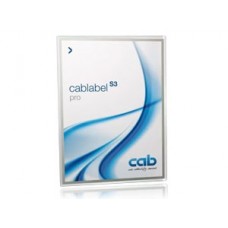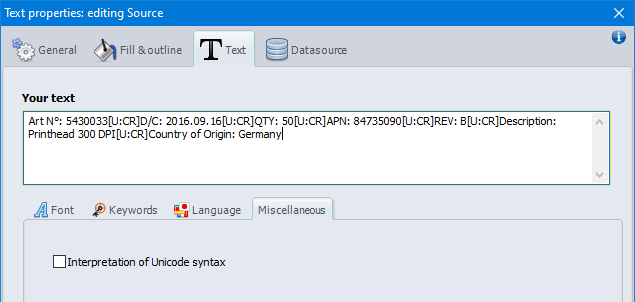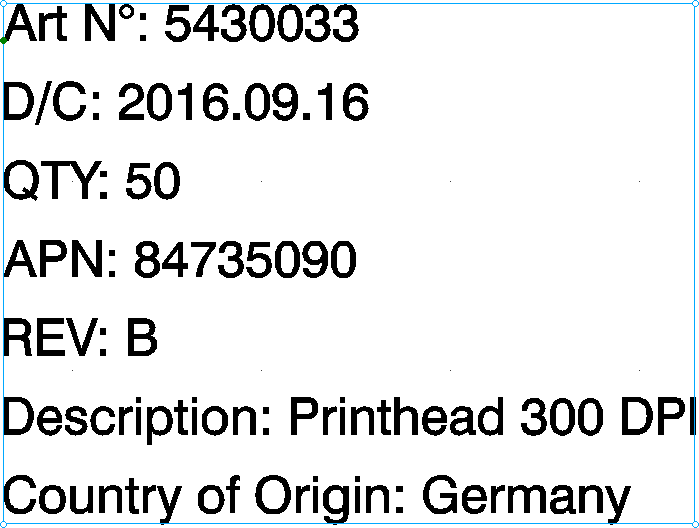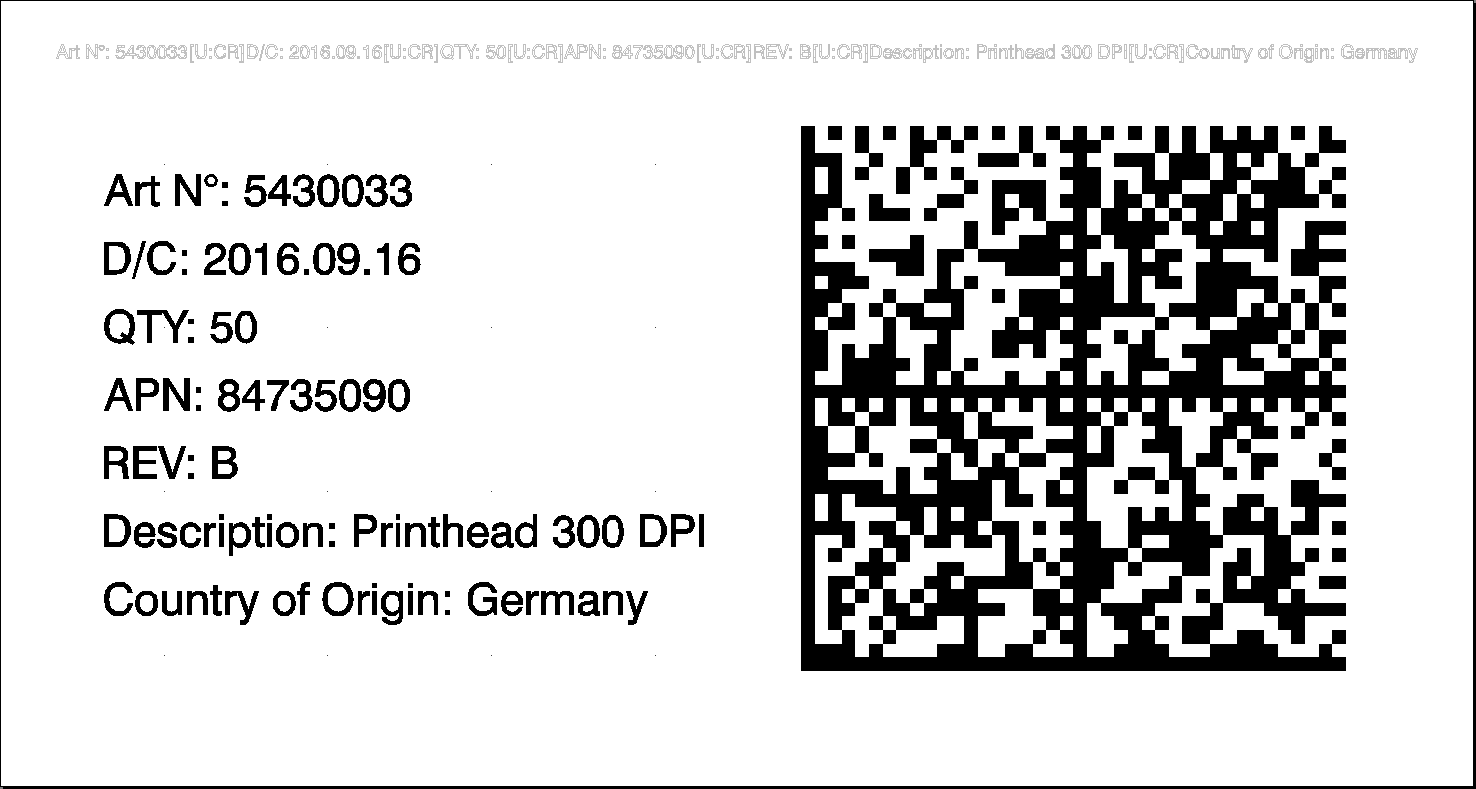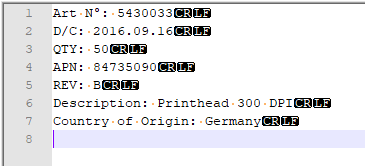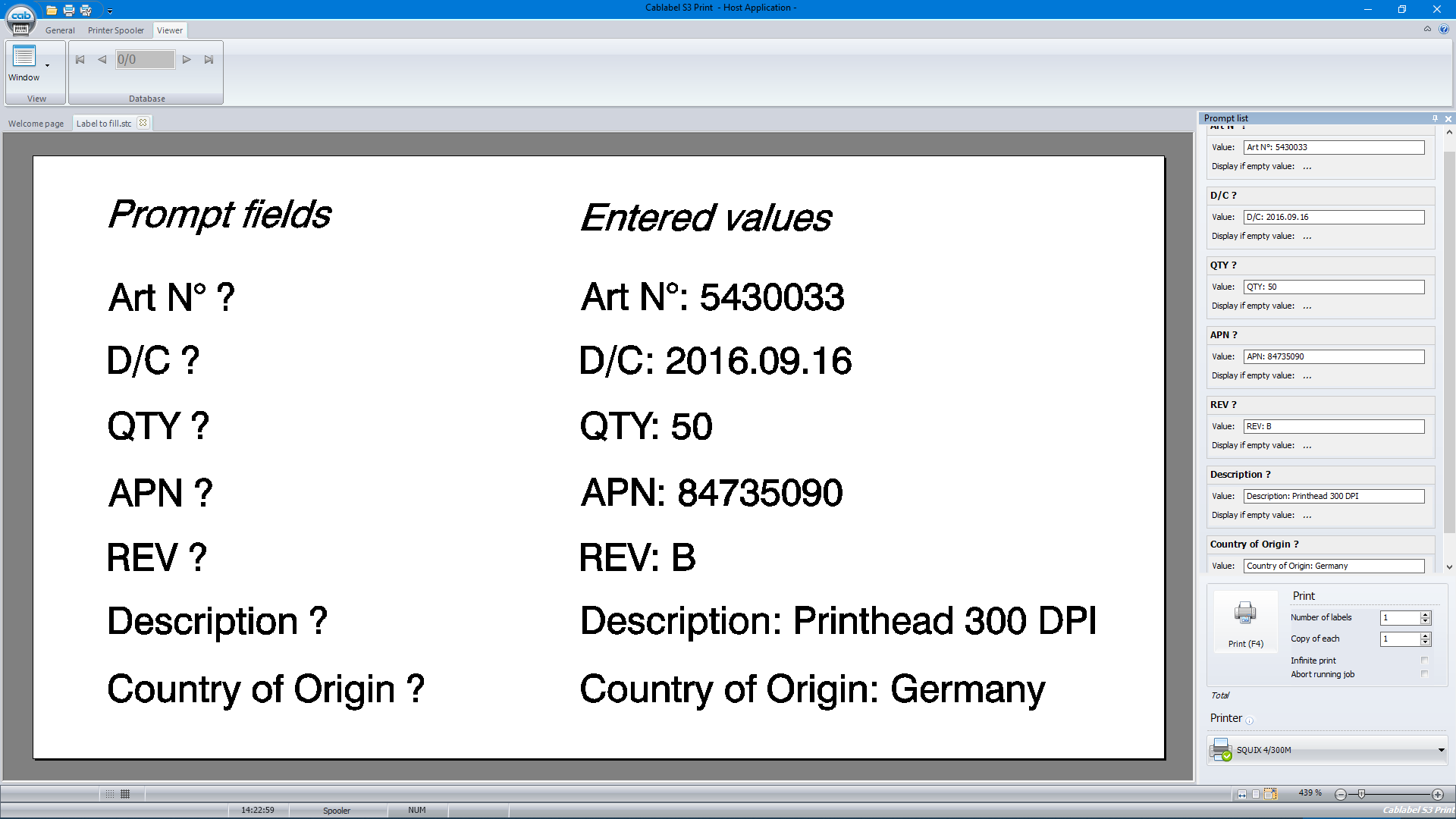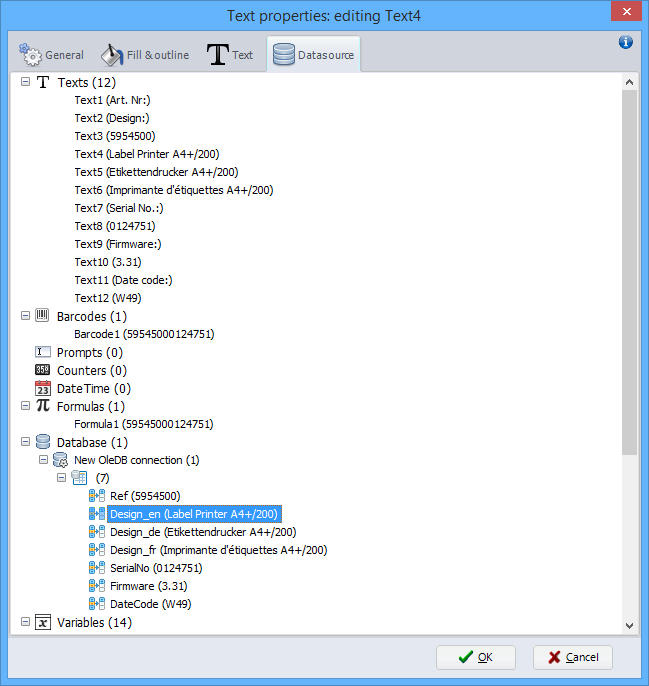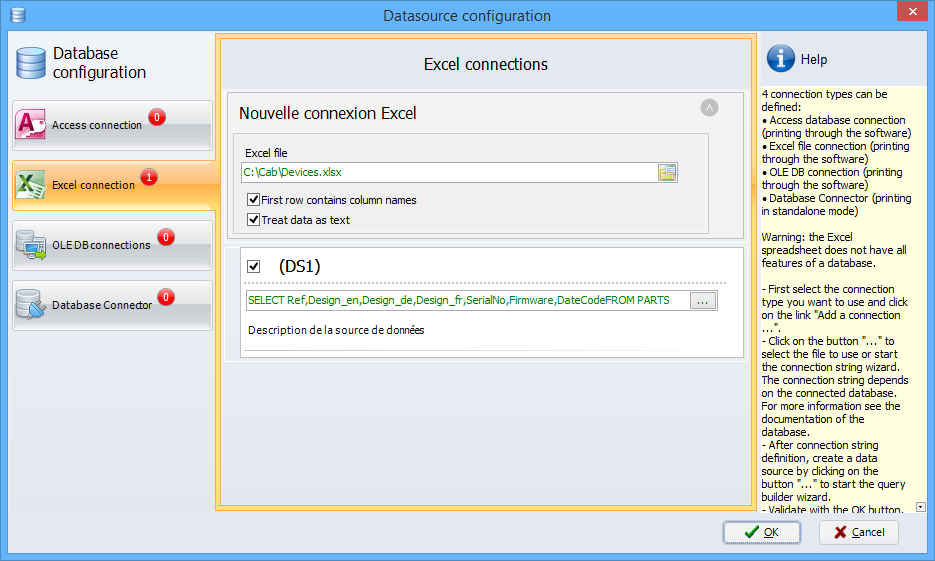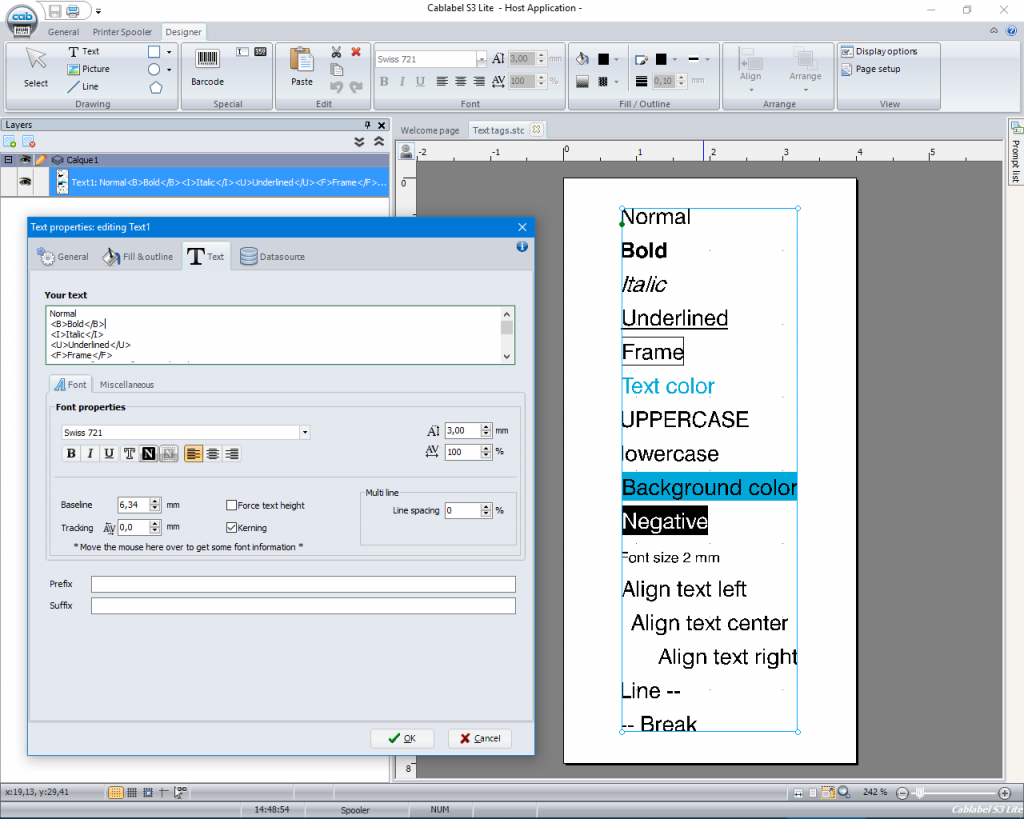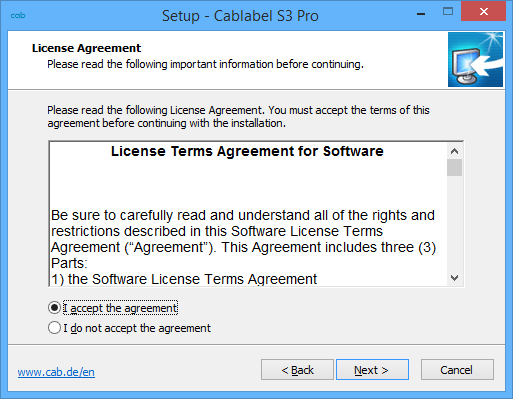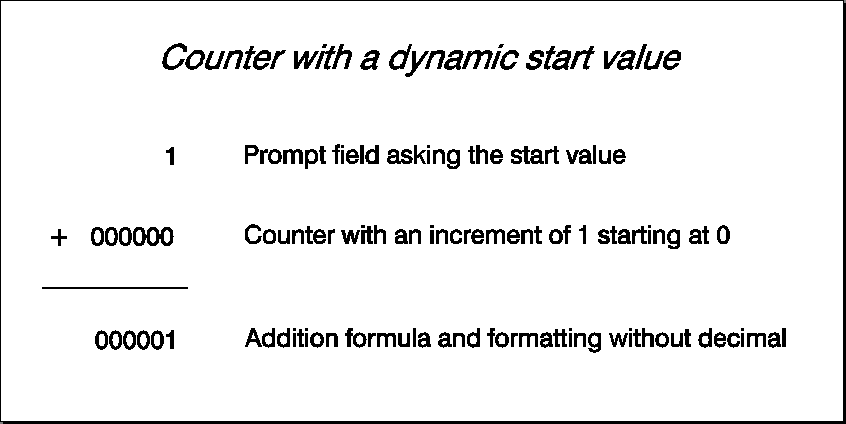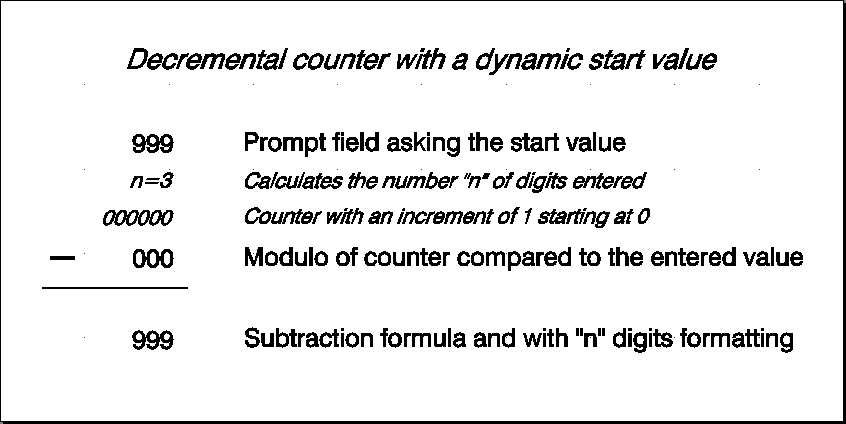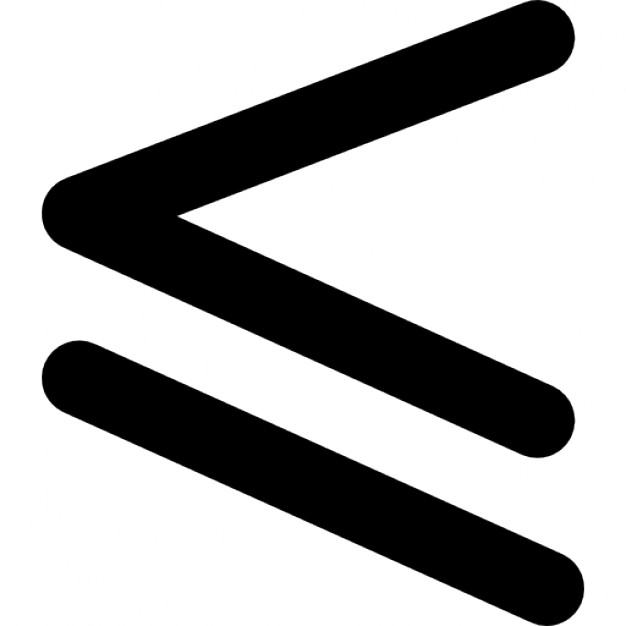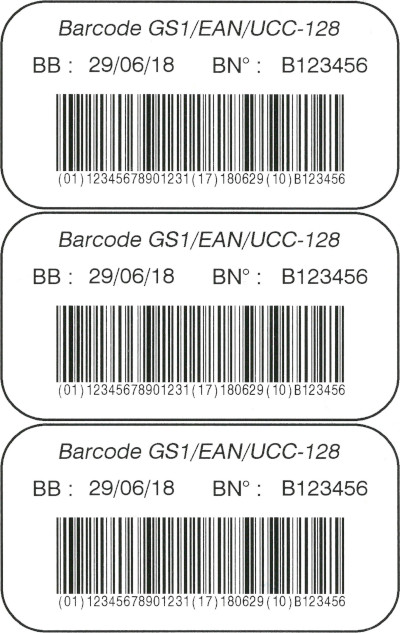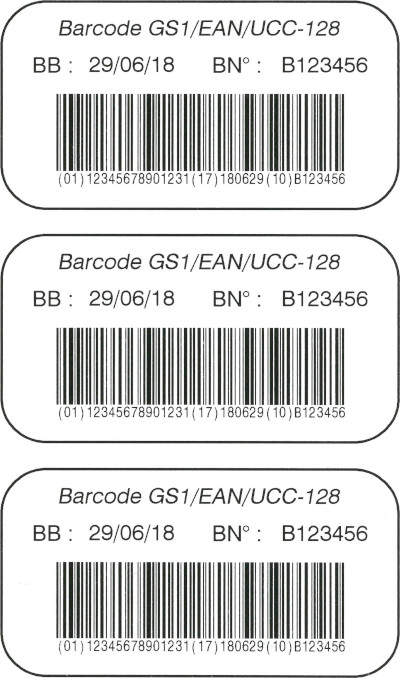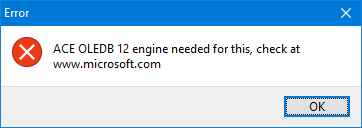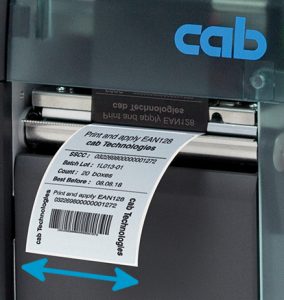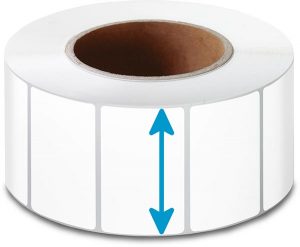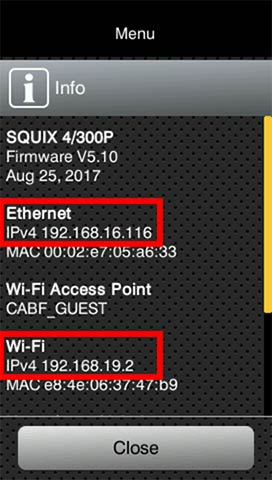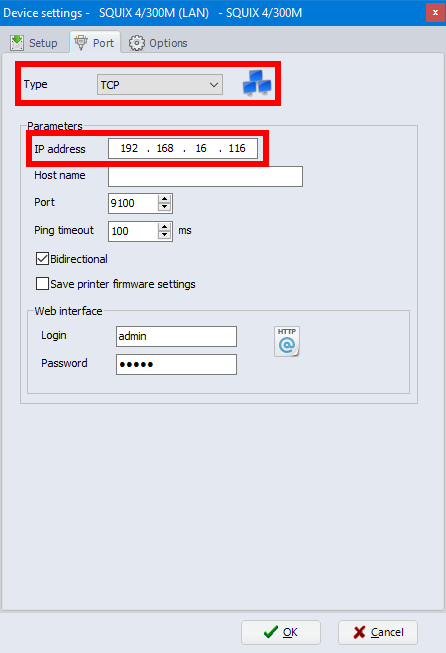На чтение 11 мин Просмотров 1.1к. Опубликовано 24.10.2020
Программное обеспечение для маркировки Cablabel S3 Proот CAB является решением для профессионального дизайна этикеток в промышленном секторе. В программу интегрированы три основные функции: создание, печать и управление заданиями на печать этикеток. Программа разработана по модульному принципу и может быть постепенно адаптирована к вашим потребностям. Для упрощения ваших задач был создан полный набор функций и инструментов: в программу включены расширенные функции счетчика, поля даты, формулы и соединение с базой данных. В программном обеспечении cablabel ваши индивидуальные отпечатки этикеток являются гибкими, поскольку программа может подключаться ко всем системам этикеток CAB. Cablabel также поддерживает автономный режим, а такие элементы, как JScript Viewer, интегрируются через плагин, чтобы наилучшим образом поддерживать нативное программирование Jscript. Поскольку cablabel также может импортировать уже существующие файлы JScript, переключение легко и быстро. Если метка изменяется в интерфейсе конструктора, информация автоматически обновляется в Jscript-Viewer (в режиме реального времени). Специальные функции, такие как Database Connector или Barcode Analyzers, могут быть легко интегрированы.
Функции:
cablabel S3 Lite
cablabel S3 Pro
Поставляется с каждым принтером
Лицензия на компьютер по запросу
Совместим только с кабельными принтерами
Поддерживает все принтеры, обнаруженные и установленные в Windows
Дополнительные параметры текста: максимальная ширина и переносы
Текстовое поле с различными наценками по определению ключевых слов (например, аллергены)
Мастер отображения символов для вставки специальных символов
Растровая графика только типа bmp, jpg, tif,…
Также векторная графика типа dxf, plt, svg,…
Около 30 видов штрих-кодов линейных, 2D, GS1 и композитных
Около 35 типов штрих-кодов, включая варианты EAN 18/128
Мастер штрих-кода для создания GS1 / EAN / UCC-128, FACT / MH10 и QR
Опция проверки штрих-кода
Подскажите поля с бесплатным входом
Дополнительные параметры поля приглашения: маска ввода и список выбора
Мастер создания составных подсказок
Счетчики базовые типа числовые и приращения +/- 1
Счетчики расширенные типов буквенно-цифровых и приращения +/- n
Дополнительные параметры счетчика: частота, сброс и сохранение значения
Дата и время, включая смещения и мастера для создания формата
Формула: математические операции, манипуляции со строками и т. Д.
ABC базовый компилятор с библиотекой кода
Переменные: источники данных с информацией о этикетке, принтере, компьютере и т. Д.
Подключение к: Доступ, файлы Excel, базы данных OLE DB, ODBC, ASCII, Database Connector в автономном режиме
Просмотрщик кода JScript для обзора на лету
Импорт файлов JScript в формате LBL
Сохранение только в формате STC
Также экспорт в формат PDF и изображение PNG
First create a text object, by filling in the data on one line. When you need to add a line break, do not use the “Enter” key on the keyboard, but instead insert the special character “Carriage Return”, using the character map of cablabel S3 Pro.
Then disable the interpretation of Unicode syntax, to display the text as it is in the software. And if you do not want to print this source text, just make it invisible for printing.
- Creation of the multi line text
Then create a new text object, having as datasource the text object created previously.
Since the interpretation of Unicode syntax is by default enabled, the text is then displayed over multiple lines, because the carriage return is automatically interpreted by the software.
And of course, this multi line text is printed as shown on the screen (What You See Is What You Get).
Notice: since the content of the multi line text is dynamic, this object is sent to the printer as a picture.
- Creation of the barcode
Finally create the barcode, having also as datasource the text object created at first.
In this way, when you need to update the data, only modify the source text. The changes are then automatically propagated to linked objects, in this case the multi line text and the barcode.
Good to know: the carriage return is encoded as well and can possibly be interpreted when reading the barcode. This will depend on used reading device and its configuration.
- To go further
In order to check the contents of a barcode, you can use an app with the smartphone, but not all show the special characters. Another method is to simply connect a barcode reader to the computer, then to create a new text file with Notepad++ and to show all characters.
Finally, this DataMatrix can then be used to automatically fill in the input fields of another label, for example in cablabel S3 Print or even in standalone mode. Thus the operator will perform only one action, that is reading the barcode, instead of having to fill in and validate individually each prompt field.
Attention: in this case, it is strongly recommended to first configure the barcode reader, in order to add a delay after the validation of a prompt field. Because depending on the response time of the computer or the printer, the read information may arrive too fast to be processed correctly.
Download example files for cablabel S3 Pro:
First, to better understand the vocabulary from this environment, here is a correspondence of the main terms used in Excel and a database:
| Excel | Access or other databases |
| Workbook or Excel file | Database or Access file |
| Sheet | Table |
| Column | Field |
| Row | Record |
| Cells | Data |
With cablabel S3 Pro, it is possible to define a connection to an Excel and Access file or any other database, allowing to create new data sources that can be used dynamically by the label objects.
Of course, the choice of the database depends particularly on, the advantages and disadvantages of each solution, the hardware and software budget, the knowledge of each, etc.
Good to know: it is not mandatory to install Excel or Access on all computers with cablabel S3 Pro or Print, because the OLE DB provider “Access Database Engine” from Microsoft is sufficient to connect to the data files.
Thereby, the Excel workbook is often favoured for creating and managing a data source, since it has the advantage of being relatively simple and convenient to use. But in order to be fully exploitable with cablabel S3, there are nevertheless some precautions to take:
- Do not use spaces or other special characters in the name of the sheets.
- Do not add empty rows, titles or other texts at the beginning of the sheet.
- The first row of a sheet must imperatively contain, either the field names or the first record.
- Raw data should be preferred, by avoiding applying to the cells a format or a formatting specific to Excel.
Without forgetting that the Excel spreadsheet does not have all features of a database, and that some disadvantages are also to be taken into account:
- Depending on the versions, it is possible to have only one access per file. The same data source can therefore not be used simultaneously by Excel and the cablabel S3 software.
- There is no optimization, like that brought by indexing data. Queries on large tables are therefore longer.
- The field type “BLOB” does not exist. It is therefore for example impossible to save the label in the database.
More information on this subject is also available on the Microsoft website:
In summary, a properly structured Excel workbook, is very suitable for creating a small data source with a dedicated use for cablabel S3.
However, as soon as you have a need for simultaneous access or better performance, it is then better to opt for Access or another database, knowing that the data can be transferred quite easily.
When designing a label in cablabel S3, the different properties of a text (bold, italic…) are applied to the entire content of the object.
With the Pro and Print version, the keywords plugin allows to highlight automatically specific words in a sentence or text, as for example for the allergens.
Since the version 1.2.0.1 of the software, you can now use text tags.
Based on the principle of HTML language, this new feature provides the ability to change manually the formatting of a text part.
Moreover, you can also insert these tags in other editable fields, such as the prefix or the suffix of a text, the operations of a formula, or even directly into your database.
The software will then interpret them and display the result of the formatting on the screen, as it will later be printed on the label.
The whole list of the text tags is available in the Operator’s manual of software (PDF, 5 MB).
Download example file for cablabel S3 Lite and Pro:
Yes of course, but only according to the case and under certain conditions.
Here is a summary of different situations needing the activation of the software and how to proceed.
In order to benefit from the latest features provided by the addition of plugins, as the keywords, the variable information or the compound prompts, sometimes a reactivation of the software is required after its update.
In this example, some plugins are not correctly loaded. Then you mostly just have to redo an activation procedure through the wizard, reachable from the “About” button in the General tab.
- Reinstallation
If you need to reinstall the software, for example due to change of computer or operating system, there is the possibility to perform a request for reactivation, by filling in the form available on our website:
Once your request has been considered, you will then receive the necessary instructions by email at the address indicated.
- Additional installation
On the other hand, when you wish to use the software on an additional workstation, you first have to purchase either an additional license or a new license.
For more information about this subject or to know all the modalities, you can contact directly your usual reseller.
When designing my label, I created a counter and set a starting value.
But how can I change this value dynamically, without having to edit each time the properties of my counter?
In order to perform this easily in standalone mode, you need:
- To create a prompt field asking the start value.
- To insert a basic counter of numeric type.
- Then to add together both values with a formula.
And to go further, here is a more complex design in formular mode with:
- a decremental counter.
- a dynamic formatting in relation to the number of digits entered.
- an automatic reset of the counter, when the current value reaches 1.
Attention: if an operation of the “Math” category is calculated directly on the printer (for example using operands from a datasource), the result is printed by default with 2 digits after the comma.
To change this behaviour, you have as in these cases, to add a “Formatting” operation.
Download example files for cablabel S3 Pro:
You want to create your labels with cablabel S3, but you don’t know which version to choose?
In order to help you to make this decision based on your needs, here is a summary of the main differences and exclusive possibilities:
| cablabel S3 Lite | cablabel S3 Pro |
| Delivered with every printer | License per computer on request |
| Compatible with cab printers only |
Supports all printers detected and installed on Windows |
| Additional text options: max width and hyphenation |
|
| Text box with various markups by keyword detection (e.g. allergens) |
|
| Character map wizard for inserting special characters |
|
| Raster graphics only of type bmp, jpg, tif, … |
Also vector graphics of type dxf, plt, svg, … |
| About 30 types of barcodes linear, 2D, GS1 and composite |
About 35 types of barcodes including the EAN 18/128 variants |
| Barcode wizard for creating GS1/EAN /UCC-128, FACT/MH10 and QR |
|
| – | Barcode verifier option |
| Additional prompt field options: input mask and choice list |
|
| Wizard for creating compound prompts |
|
| Counters basic of type numeric and increment +/-1 |
Counters advanced of types alphanumeric and increment +/-n |
| Additional counter options: frequency, resetting and saving of the value |
|
| Date and time including offsets and wizards for creating the format |
|
| Formula: mathematical operations, manipulate strings, etc. |
|
| ABC basic compiler with code library |
|
| Variables: data sources with information about the label, the printer, the computer, etc. |
|
| Connection to: Access, Excel files, OLE DB, ODBC, ASCII databases, Database Connector in stand alone mode |
|
| JScript code viewer for an overview on the fly |
|
| – | Import of JScript files in LBL format |
| Saving only in STC format |
Also export to PDF format and PNG image |
More information is also available on our website:
Another property to check in the layout is the “gap”, even if the default value of 3 mm is suitable for most of the labels.
This dimension corresponds to the distance between the labels, and is also measured in the printing direction or in the unwinding direction of the label roll.
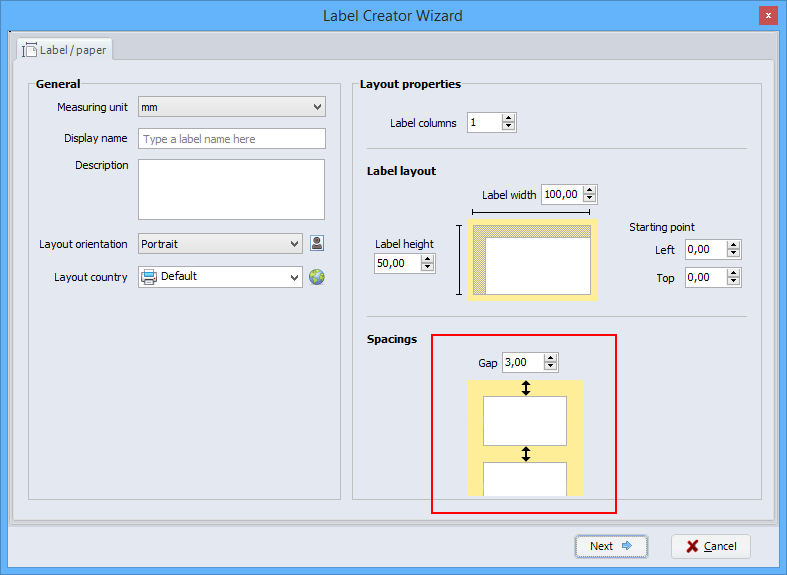
In case of using a material with a gap, you have therefore to be careful that the value indicated in the layout is simply lower or equal to the value measured between the labels:
This avoids some detection problems by the label sensor of printer and especially the emergence of non-printed labels.
And in case of using a continuous material, you are free to set a gap value:
- for example to print the labels one after the other.
- or to intentionally leave more space between each label.
When you try to connect with cablabel S3 Pro to an Excel or Access file, created with the version 2007 or later, and you get the following error message:
Then it is necessary to download and install the 32-bit version of the OLE DB provider “Access Database Engine” from the following Microsoft website:
Notice: if the setup of Access Database Engine warns you that a 64-bit version of Microsoft Office is already installed, you must start it manually by the command prompt “cmd”, from the file location and also with the parameter “/quiet” behind the file name.
Let’s see some tips, to find more easily the size of a label and especially to avoid mixing the measures.
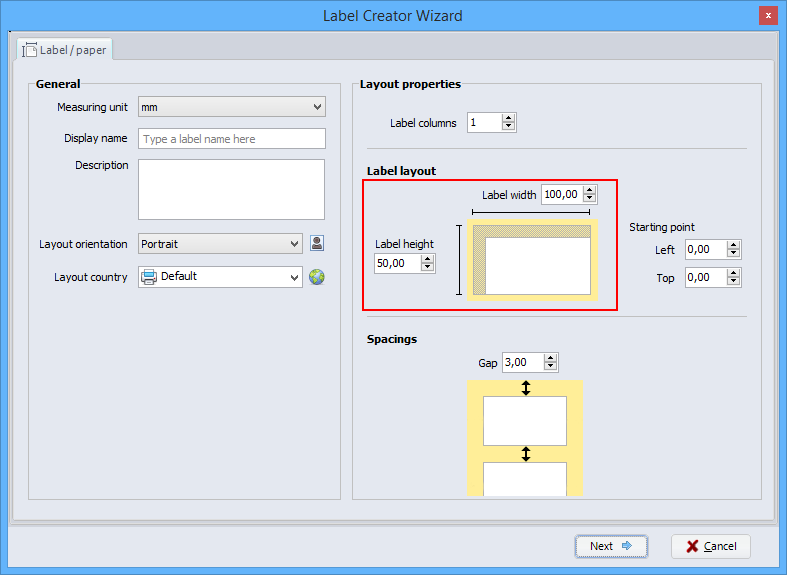
The first number corresponds to the width and the second to the height.
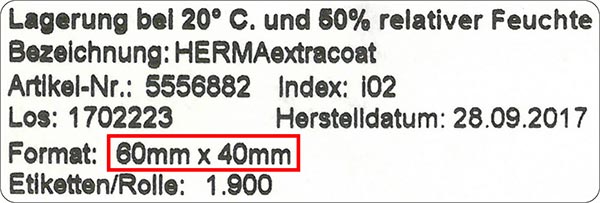
-
Format 60×40 mm ⇒ w >You can also directly measure the size of the label. But in this case, you must be careful to correctly identify the width.
The height coincides then with the label feed, in the printing direction or in the unwinding direction of label roll. The size of the label is therefore independent of its orientation and also of the reading direction!
Click on the following link, to see some examples of measurements:
You will use cablabel S3 with a cab printer connected to the network?
To connect the printer, you need first to:
- Connect the cab printer to the network with a not provided Ethernet cable or if appropriate by Wi-Fi.
- After that restart the printer.
- And search in the « Short status » menu, the information about the IPv4 address corresponding to your used connection type.
Attention: for the assignment or reservation of an IP address, please contact your system administrator.
To configure cablabel S3 you need to:
- First, install or update your cablabel S3 version.
- After that add a new device corresponding to your model.
- Then select the « TCP » port type and fill in the IP address previously collected on the printer.
Notice: the installation of the Windows driver is only necessary for the MACH1 and MACH2 printers, or if you want to use a cab printer from the network with any other software.
For more information or for an installation of the Windows driver, download the detailed guide:
Характеристики
для контроля, для печати, для разработки
Описание
конструкция ярлыка шлихов cablabel S3, управление печати и контроль всех систем маркировки кабины. Развитие приборов и програмного обеспечения синхронизировано.
Это автоматический перевод. (просмотреть оригинал на английском языке)
«>
Программное обеспечение для маркировки Cablabel S3 Proот CAB является решением для профессионального дизайна этикеток в промышленном секторе. В программу интегрированы три основные функции: создание, печать и управление заданиями на печать этикеток. Программа разработана по модульному принципу и может быть постепенно адаптирована к вашим потребностям. Для упрощения ваших задач был создан полный набор функций и инструментов: в программу включены расширенные функции счетчика, поля даты, формулы и соединение с базой данных. В программном обеспечении cablabel ваши индивидуальные отпечатки этикеток являются гибкими, поскольку программа может подключаться ко всем системам этикеток CAB. Cablabel также поддерживает автономный режим, а такие элементы, как JScript Viewer, интегрируются через плагин, чтобы наилучшим образом поддерживать нативное программирование Jscript. Поскольку cablabel также может импортировать уже существующие файлы JScript, переключение легко и быстро. Если метка изменяется в интерфейсе конструктора, информация автоматически обновляется в Jscript-Viewer (в режиме реального времени). Специальные функции, такие как Database Connector или Barcode Analyzers, могут быть легко интегрированы.
Функции:
cablabel S3 Lite
cablabel S3 Pro
Поставляется с каждым принтером
Лицензия на компьютер по запросу
Совместим только с кабельными принтерами
Поддерживает все принтеры, обнаруженные и установленные в Windows
Дополнительные параметры текста: максимальная ширина и переносы
Текстовое поле с различными наценками по определению ключевых слов (например, аллергены)
Мастер отображения символов для вставки специальных символов
Растровая графика только типа bmp, jpg, tif,…
Также векторная графика типа dxf, plt, svg,…
Около 30 видов штрих-кодов линейных, 2D, GS1 и композитных
Около 35 типов штрих-кодов, включая варианты EAN 18/128
Мастер штрих-кода для создания GS1 / EAN / UCC-128, FACT / MH10 и QR
Опция проверки штрих-кода
Подскажите поля с бесплатным входом
Дополнительные параметры поля приглашения: маска ввода и список выбора
Мастер создания составных подсказок
Счетчики базовые типа числовые и приращения +/- 1
Счетчики расширенные типов буквенно-цифровых и приращения +/- n
Дополнительные параметры счетчика: частота, сброс и сохранение значения
Дата и время, включая смещения и мастера для создания формата
Формула: математические операции, манипуляции со строками и т. Д.
ABC базовый компилятор с библиотекой кода
Переменные: источники данных с информацией о этикетке, принтере, компьютере и т. Д.
Подключение к: Доступ, файлы Excel, базы данных OLE DB, ODBC, ASCII, Database Connector в автономном режиме
Просмотрщик кода JScript для обзора на лету
Импорт файлов JScript в формате LBL
Сохранение только в формате STC
Также экспорт в формат PDF и изображение PNG
First create a text object, by filling in the data on one line. When you need to add a line break, do not use the “Enter” key on the keyboard, but instead insert the special character “Carriage Return”, using the character map of cablabel S3 Pro.
Then disable the interpretation of Unicode syntax, to display the text as it is in the software. And if you do not want to print this source text, just make it invisible for printing.
- Creation of the multi line text
Then create a new text object, having as datasource the text object created previously.
Since the interpretation of Unicode syntax is by default enabled, the text is then displayed over multiple lines, because the carriage return is automatically interpreted by the software.
And of course, this multi line text is printed as shown on the screen (What You See Is What You Get).
Notice: since the content of the multi line text is dynamic, this object is sent to the printer as a picture.
- Creation of the barcode
Finally create the barcode, having also as datasource the text object created at first.
In this way, when you need to update the data, only modify the source text. The changes are then automatically propagated to linked objects, in this case the multi line text and the barcode.
Good to know: the carriage return is encoded as well and can possibly be interpreted when reading the barcode. This will depend on used reading device and its configuration.
- To go further
In order to check the contents of a barcode, you can use an app with the smartphone, but not all show the special characters. Another method is to simply connect a barcode reader to the computer, then to create a new text file with Notepad++ and to show all characters.
Finally, this DataMatrix can then be used to automatically fill in the input fields of another label, for example in cablabel S3 Print or even in standalone mode. Thus the operator will perform only one action, that is reading the barcode, instead of having to fill in and validate individually each prompt field.
Attention: in this case, it is strongly recommended to first configure the barcode reader, in order to add a delay after the validation of a prompt field. Because depending on the response time of the computer or the printer, the read information may arrive too fast to be processed correctly.
Download example files for cablabel S3 Pro:
First, to better understand the vocabulary from this environment, here is a correspondence of the main terms used in Excel and a database:
| Excel | Access or other databases |
| Workbook or Excel file | Database or Access file |
| Sheet | Table |
| Column | Field |
| Row | Record |
| Cells | Data |
With cablabel S3 Pro, it is possible to define a connection to an Excel and Access file or any other database, allowing to create new data sources that can be used dynamically by the label objects.
Of course, the choice of the database depends particularly on, the advantages and disadvantages of each solution, the hardware and software budget, the knowledge of each, etc.
Good to know: it is not mandatory to install Excel or Access on all computers with cablabel S3 Pro or Print, because the OLE DB provider “Access Database Engine” from Microsoft is sufficient to connect to the data files.
Thereby, the Excel workbook is often favoured for creating and managing a data source, since it has the advantage of being relatively simple and convenient to use. But in order to be fully exploitable with cablabel S3, there are nevertheless some precautions to take:
- Do not use spaces or other special characters in the name of the sheets.
- Do not add empty rows, titles or other texts at the beginning of the sheet.
- The first row of a sheet must imperatively contain, either the field names or the first record.
- Raw data should be preferred, by avoiding applying to the cells a format or a formatting specific to Excel.
Without forgetting that the Excel spreadsheet does not have all features of a database, and that some disadvantages are also to be taken into account:
- Depending on the versions, it is possible to have only one access per file. The same data source can therefore not be used simultaneously by Excel and the cablabel S3 software.
- There is no optimization, like that brought by indexing data. Queries on large tables are therefore longer.
- The field type “BLOB” does not exist. It is therefore for example impossible to save the label in the database.
More information on this subject is also available on the Microsoft website:
In summary, a properly structured Excel workbook, is very suitable for creating a small data source with a dedicated use for cablabel S3.
However, as soon as you have a need for simultaneous access or better performance, it is then better to opt for Access or another database, knowing that the data can be transferred quite easily.
When designing a label in cablabel S3, the different properties of a text (bold, italic…) are applied to the entire content of the object.
With the Pro and Print version, the keywords plugin allows to highlight automatically specific words in a sentence or text, as for example for the allergens.
Since the version 1.2.0.1 of the software, you can now use text tags.
Based on the principle of HTML language, this new feature provides the ability to change manually the formatting of a text part.
Moreover, you can also insert these tags in other editable fields, such as the prefix or the suffix of a text, the operations of a formula, or even directly into your database.
The software will then interpret them and display the result of the formatting on the screen, as it will later be printed on the label.
The whole list of the text tags is available in the Operator’s manual of software (PDF, 5 MB).
Download example file for cablabel S3 Lite and Pro:
Yes of course, but only according to the case and under certain conditions.
Here is a summary of different situations needing the activation of the software and how to proceed.
In order to benefit from the latest features provided by the addition of plugins, as the keywords, the variable information or the compound prompts, sometimes a reactivation of the software is required after its update.
In this example, some plugins are not correctly loaded. Then you mostly just have to redo an activation procedure through the wizard, reachable from the “About” button in the General tab.
- Reinstallation
If you need to reinstall the software, for example due to change of computer or operating system, there is the possibility to perform a request for reactivation, by filling in the form available on our website:
Once your request has been considered, you will then receive the necessary instructions by email at the address indicated.
- Additional installation
On the other hand, when you wish to use the software on an additional workstation, you first have to purchase either an additional license or a new license.
For more information about this subject or to know all the modalities, you can contact directly your usual reseller.
When designing my label, I created a counter and set a starting value.
But how can I change this value dynamically, without having to edit each time the properties of my counter?
In order to perform this easily in standalone mode, you need:
- To create a prompt field asking the start value.
- To insert a basic counter of numeric type.
- Then to add together both values with a formula.
And to go further, here is a more complex design in formular mode with:
- a decremental counter.
- a dynamic formatting in relation to the number of digits entered.
- an automatic reset of the counter, when the current value reaches 1.
Attention: if an operation of the “Math” category is calculated directly on the printer (for example using operands from a datasource), the result is printed by default with 2 digits after the comma.
To change this behaviour, you have as in these cases, to add a “Formatting” operation.
Download example files for cablabel S3 Pro:
You want to create your labels with cablabel S3, but you don’t know which version to choose?
In order to help you to make this decision based on your needs, here is a summary of the main differences and exclusive possibilities:
| cablabel S3 Lite | cablabel S3 Pro |
| Delivered with every printer | License per computer on request |
| Compatible with cab printers only |
Supports all printers detected and installed on Windows |
| Additional text options: max width and hyphenation |
|
| Text box with various markups by keyword detection (e.g. allergens) |
|
| Character map wizard for inserting special characters |
|
| Raster graphics only of type bmp, jpg, tif, … |
Also vector graphics of type dxf, plt, svg, … |
| About 30 types of barcodes linear, 2D, GS1 and composite |
About 35 types of barcodes including the EAN 18/128 variants |
| Barcode wizard for creating GS1/EAN /UCC-128, FACT/MH10 and QR |
|
| – | Barcode verifier option |
| Additional prompt field options: input mask and choice list |
|
| Wizard for creating compound prompts |
|
| Counters basic of type numeric and increment +/-1 |
Counters advanced of types alphanumeric and increment +/-n |
| Additional counter options: frequency, resetting and saving of the value |
|
| Date and time including offsets and wizards for creating the format |
|
| Formula: mathematical operations, manipulate strings, etc. |
|
| ABC basic compiler with code library |
|
| Variables: data sources with information about the label, the printer, the computer, etc. |
|
| Connection to: Access, Excel files, OLE DB, ODBC, ASCII databases, Database Connector in stand alone mode |
|
| JScript code viewer for an overview on the fly |
|
| – | Import of JScript files in LBL format |
| Saving only in STC format |
Also export to PDF format and PNG image |
More information is also available on our website:
Another property to check in the layout is the “gap”, even if the default value of 3 mm is suitable for most of the labels.
This dimension corresponds to the distance between the labels, and is also measured in the printing direction or in the unwinding direction of the label roll.

In case of using a material with a gap, you have therefore to be careful that the value indicated in the layout is simply lower or equal to the value measured between the labels:
This avoids some detection problems by the label sensor of printer and especially the emergence of non-printed labels.
And in case of using a continuous material, you are free to set a gap value:
- for example to print the labels one after the other.
- or to intentionally leave more space between each label.
When you try to connect with cablabel S3 Pro to an Excel or Access file, created with the version 2007 or later, and you get the following error message:
Then it is necessary to download and install the 32-bit version of the OLE DB provider “Access Database Engine” from the following Microsoft website:
Notice: if the setup of Access Database Engine warns you that a 64-bit version of Microsoft Office is already installed, you must start it manually by the command prompt “cmd”, from the file location and also with the parameter “/quiet” behind the file name.
Let’s see some tips, to find more easily the size of a label and especially to avoid mixing the measures.

The first number corresponds to the width and the second to the height.

-
Format 60×40 mm ⇒ w >You can also directly measure the size of the label. But in this case, you must be careful to correctly identify the width.
The height coincides then with the label feed, in the printing direction or in the unwinding direction of label roll. The size of the label is therefore independent of its orientation and also of the reading direction!
Click on the following link, to see some examples of measurements:
You will use cablabel S3 with a cab printer connected to the network?
To connect the printer, you need first to:
- Connect the cab printer to the network with a not provided Ethernet cable or if appropriate by Wi-Fi.
- After that restart the printer.
- And search in the « Short status » menu, the information about the IPv4 address corresponding to your used connection type.
Attention: for the assignment or reservation of an IP address, please contact your system administrator.
To configure cablabel S3 you need to:
- First, install or update your cablabel S3 version.
- After that add a new device corresponding to your model.
- Then select the « TCP » port type and fill in the IP address previously collected on the printer.
Notice: the installation of the Windows driver is only necessary for the MACH1 and MACH2 printers, or if you want to use a cab printer from the network with any other software.
For more information or for an installation of the Windows driver, download the detailed guide:
Характеристики
для контроля, для печати, для разработки
Описание
конструкция ярлыка шлихов cablabel S3, управление печати и контроль всех систем маркировки кабины. Развитие приборов и програмного обеспечения синхронизировано.
Это автоматический перевод. (просмотреть оригинал на английском языке)
«>
Operator's Manual
cablabel S3
2 Operator's Manual
for the following products
2
Family
Art. Nr
Labelling Software cablabel S3
Type
5588000
cablabel S3 Lite
5588009
cablabel S3 Demo
5588001
cablabel S3 Pro
5588010
cablabel S3 Pro Laser
Edition: 06/2017 - Part. No.: 9009606
Copyright
This documentation as well as translation hereof are property of cab Produkttechnik GmbH & Co. KG.
The replication, conversion, duplication or divulgement of the whole manual or parts of it for other intentions than its original
intended purpose demand the previous written authorization by cab.
Trademark
Microsoft® is a registered trademark of the Microsoft Corporation.
Windows® is a registered trademark of the Microsoft Corporation.
TrueTypeTM is a registered trademark of the Apple Computer, Inc.
Editor
Regarding questions or comments please contact cab Produkttechnik GmbH & Co. KG.
Topicality
Due to the constant further development of our products discrepancies between documentation and product can occur.
Please check www.cab.de for the latest update.
Terms and conditions
Deliveries and performances are effected under the General conditions of sale of cab.
Germany
cab Produkttechnik
GmbH & Co KG
Wilhelm-Schickard-Str. 14
76131 Karlsruhe
Tel.+49 721 6626 0
Fax+49 721 6626 129
[email protected]
www.cab.de
France
cab Technologies s.à.r.l.
2a rue de la Moder
Z.A. Nord du Val de Moder
67350 Niedermodern
Tel.+33 388 722501
Fax+33 388 722502
[email protected]
www.cab-technologies.fr
Latin America
Alejandro Balmaceda
Hacienda Jurica Pte 1615
Colonial de Valle
32553 Ciudad Juárez
Tel.+52 656 682 3745
Fax+52 656 682 4301
[email protected]
www.cab.de/es
cab Produkttechnik
Sömmerda GmbH
Am Unterwege 18-20
99610 Sömmerda
Tel.+49 3634 6860 0
Fax+49 3634 6860 129
[email protected]
www.cab.de
USA
cab Technology, Inc.
87 Progress Avenue Unit 1
Tyngsboro, MA 01879
Tel.+1 978 649 0293
Fax+1 978 649 0294
[email protected]
www.cab.de/us
South Africa
cab Technology (Pty) Ltd.
14 Republic Street
Bordeaux
2125 Randburg
Tel.+27 11 886 3580
Fax+27 11 789 3913
[email protected]
www.cab.de/za
Representatives in other countries on request.
Taiwan
cab Technology Co., Ltd.
16F-1, No. 700, Jhong Jheng Rd
Junghe, Taipeh 23552
Tel.+886 (02) 8227 3966
Fax+886 (02) 8227 3566
[email protected]
www.cab.de/tw
China
cab (Shanghai) Trading Co., Ltd
A507, No. 268, Tong Xie Rd
Shanghai 200335
Tel.+86 (021) 6236 3161
Fax+86 (021) 6236 3162
[email protected]
www.cab.de/cn
Table of contents
1Introduction............................................................................................................................................. 5
1.1Instructions................................................................................................................................................ 5
1.2 System requirements................................................................................................................................ 5
1.3 cablabel S3 specifications......................................................................................................................... 6
2Installation............................................................................................................................................... 7
2.1 Installing on computer............................................................................................................................... 7
2.2 Program starting........................................................................................................................................ 9
2.3Activation................................................................................................................................................. 10
2.3.1
Online activation.................................................................................................................................11
2.3.2
File activation.....................................................................................................................................11
3Overview................................................................................................................................................ 12
3.1 Main interface.......................................................................................................................................... 12
3.2Designer.................................................................................................................................................. 13
3.2.1
Drawing toolbar................................................................................................................................. 14
3.2.2
Special toolbar................................................................................................................................... 14
3.2.3
Edit toolbar........................................................................................................................................ 14
3.2.4
Font toolbar....................................................................................................................................... 15
3.2.5
Fill / Outline toolbar........................................................................................................................... 15
3.2.6
Arrange toolbar.................................................................................................................................. 16
3.2.7
Database toolbar............................................................................................................................... 17
3.2.8
View toolbar....................................................................................................................................... 17
3.2.9
Objects properties............................................................................................................................. 17
3.2.10Layers................................................................................................................................................ 18
3.2.11
Status bar.......................................................................................................................................... 19
4
Configuration......................................................................................................................................... 20
4.1 Global settings........................................................................................................................................ 20
4.1.1
General tab........................................................................................................................................ 20
4.1.2
Grid tab.............................................................................................................................................. 21
4.1.3
Object tab.......................................................................................................................................... 21
4.1.4
Background tab................................................................................................................................. 22
4.1.5
Fill & outline....................................................................................................................................... 22
4.2Devices................................................................................................................................................... 24
4.2.1
Add a device...................................................................................................................................... 24
4.2.2
Delete a device.................................................................................................................................. 25
4.2.3
Rename a device.............................................................................................................................. 25
4.2.4
Configure a device............................................................................................................................ 25
4.2.5
Device options................................................................................................................................... 26
4.2.6
System devices / Document devices................................................................................................. 26
5Use.......................................................................................................................................................... 27
5.1 New label creation................................................................................................................................... 27
5.1.1
New blank label................................................................................................................................. 27
5.1.2
New label using the wizard................................................................................................................ 28
5.1.3
New label from an existing label........................................................................................................ 28
5.2 Inserting objects in the document........................................................................................................... 28
5.2.1
Inserting texts.................................................................................................................................... 29
5.2.2
Inserting pictures............................................................................................................................... 32
5.2.3
Inserting graphical objects................................................................................................................. 33
5.2.4
Inserting barcodes............................................................................................................................. 33
5.2.5
Inserting datasource.......................................................................................................................... 34
5.2.5.1
Prompt fields................................................................................................................................ 34
5.2.5.2Counter........................................................................................................................................ 36
5.2.5.3
Datetime fields............................................................................................................................. 37
5.2.5.4Formula........................................................................................................................................ 39
5.2.5.5Variables...................................................................................................................................... 41
5.2.5.6Database..................................................................................................................................... 42
3
4 Table of contents
5.3
5.4
5.4.1
5.4.2
5.5
5.5.1
5.5.2
5.6
Document settings.................................................................................................................................. 42
Label printing........................................................................................................................................... 43
Printing on a two color printer............................................................................................................ 45
Printing on a double sided printer...................................................................................................... 45
Save a label on a memory card.............................................................................................................. 46
Saving to a printer, a card reader or a file......................................................................................... 46
Saving in a database......................................................................................................................... 47
Keyboard shortcuts................................................................................................................................. 48
6Plugins................................................................................................................................................... 50
6.1 Printer spooler......................................................................................................................................... 51
6.1.1
Managing print jobs and printer functions......................................................................................... 51
6.1.2
Printer status..................................................................................................................................... 52
6.1.3
Memory card management .............................................................................................................. 52
6.1.4
Printer display ................................................................................................................................... 53
6.2 JScript code viewer................................................................................................................................. 53
6.3 Variable information................................................................................................................................ 54
6.4 Character map........................................................................................................................................ 54
6.5 Compound prompts................................................................................................................................. 55
6.6 Barcode wizards...................................................................................................................................... 56
6.6.1
GS1/EAN/UCC-128 and GS1 Datamatrix wizard.............................................................................. 56
6.6.2
FACT/MH10 wizard........................................................................................................................... 57
6.6.3
QR wizard.......................................................................................................................................... 58
6.7 Database wizard..................................................................................................................................... 59
6.8 Layout table management....................................................................................................................... 61
6.9Keywords................................................................................................................................................ 62
7Appendix................................................................................................................................................ 64
7.1 Installation parameters............................................................................................................................ 64
7.2 Start parameters..................................................................................................................................... 66
4
1
Introduction
1.1
Instructions
Important information and instructions in this documentation are designated as follows:
Danger!
Draws your attention to an exceptionally grave, impending danger to your health or life.
!
!
i
Indicates a hazardous situation that could lead to injuries or material damage.
Attention!
Draws attention to possible dangers, material damage or loss of quality.
Notice!
Gives you tips. They make a working sequence easier or draw attention to important working processes.
Environment!
Warning!
Gives you tips on protecting the environment.
Handling instruction.
Reference to section, position, illustration number or document.
Option (accessories, devices, special fittings).
Hour
1.2
Information in the display.
System requirements
• PC with 2 GHz Processor or higher
• 32/64 bit Microsoft® Windows® operating system with latest updates:
Windows Vista Server 2008
Windows 7 Server 2008 R2
Windows 8 Server 2012
Windows 8.1 Server 2012 R2
Windows 10
• 1 GB available RAM (depending on the system)
• 500 MB available hard disk space
• Administrator rights on local computer for installation and activation
5
6 1Introduction
1.3
6
cablabel S3 specifications
Lite
Pro
Print
Print
Server(1)
(3)
General functions
Languages:
English, French, German, Spanish, Italian, Polish
Chinese (simplified and traditional), Korean
Creating labels
Printing labels
JScript code viewer
Unicode support
cab labels formats
Graphic import Raster (bmp, jpg, tif...)
Vector (plt, dxf)
Color support
Layers management
TrueType fonts
Linear and 2D barcodes
True WYSIWYG
Wizard-based user interface
Laser devices support
GS1 barcode wizard (UCC/EAN 128) and character map
Text alignment
Background image or color
Prompt fields
free
with display mask
ABC basic compiler support
ABC code library
Date and time including offsets
Counter
basic
advanced
Variable graphics
Decimals formatting
Multiline, paragraph
Text box with various markups (e.g. for highlighting allergens)
View and control of the printer display(4)
(2)
(3)
(5)
(5)
(5)
(5)
Database functions
OLE DB, ODBC, ASCII
Database Connector
Query editor
Multiple tables and databases
Import / export functions
Print to file
Export to graphic
Export to PDF
Import of JScript files
Printing functions
Interfaces: serial, parallel, USB, Ethernet, WLAN
Number of native cab printers
Printer spooler
Bidirectional communication
Standalone mode
Network printer (TCP/IP)
Windows printer and Variables
Table 1
Specifications
In progress
Except barcodes with assistant
(3)
Specific version
Depending on printer model and used port
Run queries only
(6)
Depending on license
(1)
(4)
(2)
(5)
(6)
unlimited unlimited unlimited
2
Installation
2.1
Installing on computer
i
7
Information !
It is possible to do a silent installation of cablabel S3 directly in command line.
7.1 Installation parameters.
XX Insert the delivered CD-Rom in your computer, the installation should start automatically.
If the autorun does not start or if you have downloaded the installation file, double-click on the file
« cablabelS3_XXXX_Setup.exe » to begin the installation (where XXXX matches your version).
XX Select the installation language of the program.
Figure 1
Select installation language
XX Start installation and read the user license.
Figure 2
Start of installation program
Figure 3
License agreement
8 2Installation
8
XX Enter user infomation.
Figure 4
User information
XX The program will be installed by default in the displayed folder, you can change it only if required.
Figure 5
Choose of target folder
Figure 6
Choose of start menu folder
2Installation
9
XX Select the additional tasks to be done by the installation program and check the selected options summary.
XX Click on Install.
Figure 7
Additional tasks
Figure 8
Installation summary
XX Wait until the end of the installation.
Figure 9
2.2
Installation progress
Figure 10 End of installation
Program starting
After installing cablabel S3, an icon of the program is placed on the user desktop and/or in the start menu (depending
on selected installation options).
XX Start the program by double clicking on one of these icons.
10 2Installation
2.3
Activation
Depending on the installed version, an activation is needed before you can use the program.
!
Attention!
Except the Lite version, the program cannot be used without being activated.
At the first start, a message will ask you to activate the program.
Figure 11 Program activation
After clicking on yes, the activation wizard starts.
Figure 12 Activation wizard
10
2Installation
2.3.1
Online activation
Figure 13 Online activation
XX Enter product key provided with your purchase.
XX Click on the Activate button.
The software will be automatically activated after some seconds through internet.
i
Notice!
An internet access is required for online activation.
Otherwise you will have to use the file activation.
2.3.2
File activation
Figure 14 File activation
If you don't have an internet access or if online activation did not work, it is possible to use this alternate method.
An activation request will be sent after a few steps.
In this case, after entering your product key by clicking on the Request button an email will be prepared for sending
to our activation service. The activation file will be returned to you by email once generated.
This file must be transferred to the computer where cablabel S3 is installed.
XX Select the received activation file with the suited button.
XX Click on the Activate button.
XX After activation, the software will restart automatically.
11
12 3
Overview
3.1
12
Main interface
After activation and restarting, the welcome page appears:
1
2
10
3
4
5
6
8
9
7
Figure 15 cablabel S3 welcome page
1. Quick access bar
Quick access to the most common commands (open, save ...)
2. Main button
Access to main software commands
3. Toolbar
Access to different objects and properties of selected ribbon
4. Welcome page
Starting page
5. New label
Create a new label
6. Open label
Open an existing label
7. Status bar
Status and informations
8. Recent files
List of last opened labels, with favorites pinning possibility
9. File informations
Preview and informations of the selected label
10.
/
11. Help button
Show / hide the toolbar
Access to the operator's manual you are currently reading
11
3Overview
3.2
13
Designer
The Designer let you create a label and place different objects on it.
2
1
4
3
5
Figure 16 Designer
1. Opened labels
Tab with the opened labels
2. Layout orientation
Portrait / Landscape (orientation without objects by holding "Ctrl" key)
3. Layers
Layers with the different objects
4. Prompt list
List with the different prompt fields of Formular type
5. Label
i
Label with the different objects
Notice!
The Layers (3) and the Prompt list (4), are available under the Display options button in the Designer
ribbon. 5.3 Document settings
14 3Overview
3.2.1
14
Drawing toolbar
The Drawing toolbar is composed of the most used objects on a label.
1
2
3
5
7
4
1.
2.
3.
4.
5.
6.
7.
Selection cursor
Text
Picture
Line
Rectangle and square
Polygon
Circle and ellipse
6
Figure 17 Drawing toolbar
i
3.2.2
Notice!
"Ctrl" key allows to draw the objects with a free angle, instead of an horizontal or vertical alignment.
"Alt" key allows to draw the objects starting from the center, instead of the top left corner.
Special toolbar
The Special toolbar is composed of special objects to insert a barcode or a datasource.
1
1. Barcode
2 3
5
6
2. Prompt field
3. Date / time
4. Formula
5. Counter
6. ABC code
4
Figure 18 Special toolbar
3.2.3
Edit toolbar
The Edit toolbar is composed of basic edition commands.
1. Paste
1
2
2. Cut
3
3. Delete
6
4. Undo
5. Redo
6. Copy
4
Figure 19 Edit toolbar
5
3Overview
3.2.4
15
Font toolbar
The Font toolbar is composed of different text formatting commands.
1. Font face
1
2. Font height (size) in mm
2
3. Bold
4. Italic
5. Underline
6. Left alignment
7. Center alignment
3
4
5
6
7
8
9
10
8. Right alignment
9. Font width
10. Advanced properties
Figure 20 Font toolbar
3.2.5
Fill / Outline toolbar
The Fill / Outline toolbar is composed of the different commands to change the filling and outline of a drawing
object.
1
3
1. Filling color
5
2. Filling style
3. Outline color
4. Outline size
5. Outline style
2
4
Figure 21 Fill / Outline toolbar
6
6. Advanced properties
16 3Overview
3.2.6
16
Arrange toolbar
The Arrange toolbar is composed of different commands to adjust the objects position.
1
1. Alignment of selected objects
2
2. Arrangement of selected objects
Figure 22 Arrange toolbar
1. Horizontal alignment of selected objects
1
2. Vertical alignment of selected objects
3. Centering of selected objects in the label
4. Rotation of selected objects
2
3
4
Figure 23 Alignment options
1
2
3
4
Figure 24 Arrange options
1. Objects stack up position in the label (front)
2. Objects stack up position in the label (back)
3. Group / ungroup selected objects
Selected objects are only displayed as grouped, but
sent individually to the printer.
4. Pack / unpack selected objects
Selected objects are merged and sent to the printer as
one picture.
3Overview
3.2.7
17
Database toolbar
The Database toolbar is composed of the different commands to connect and use a database.
1. Create / change database connection
2. Display the result of the query
1
3. First record
2
4. Previous record
5. Actual record position
6. Next record
3
4
5
6
7. Last record
7
Figure 25 Database toolbar
Notice!
The database toolbar appears only when the database plugin is loaded. 6.7 Database wizard
This plugin is not available in every versions of cablabel S3.
i
3.2.8
View toolbar
The View toolbar is composed of the different visual commands.
1
1. Display view settings
2. Label and paper properties
2
Figure 26 View toolbar
i
3.2.9
Notice!
It is possible to set a picture to the label background in the display options.
If you use pre-printed labels, this background picture can for example display your pre-printed label.
So you have a real view of your resulting label when placing objects on it.
Objects properties
Different options are also available by right-clicking on the objects from label or layers:
Figure 27 Objects properties
18 3Overview
18
3.2.10 Layers
Layers contain all different objects composing a label.
Each layer can be hide or locked. Each object on the layer can also be individually hide or locked in order to prevent
moving.
A layer can also be assigned to a pre-defined printing resolution. For example one layer for a 300 dpi resolution.
1. Add a new layer
2. Delete selected layer
4 5
3. Expand / Collapse all layers
1
2
4. Pin layers window
3
5. Close layers window
5
6. Edit / lock layer
7. Object visible / invisible on display and printing
7
8. Object lock
11
9. Object invisible only on printing
10. Layer visibility
11. Object preview on label
8
12
12. Object linked to another (for example linked to a
datasource)
9
10
Figure 28 Layers
i
Notice!
Layer objects assigned to a specific resolution, will only be printed on devices supporting the same resolution.
For example objects from a 200 dpi layer, will not be printed on a 300 or 600 dpi device.
This can be useful to display the real size of a barcode.
3Overview
19
Different options are available by right-clicking on the layers:
1. Display the default objects properties window
1
2. Apply the properties to all objects of the selected layer
2
3. Apply the properties to the selected object
3
4. Show a preview of the object in the label
4
5. Neutral layer device-independent
5
6. Layer forced for 200 dpi devices
6
7. Layer forced for 300 dpi devices
7
8. Layer forced for 600 dpi devices
8
9. Layer forced for laser devices
9
10. Force printing layer for the corresponding print resolution
10
11
11. If printing is not allowed, the objects in the layer are
visible on the screen but are not sent to the device
12
12. Allow to rename selected layer
Only if there are several layers in the document:
13
13. Bring the selected layers forward
14
14. Bring the selected layers to front
15
15. Send the selected layers to back
16
16. Send the selected layers backward
Figure 29 Layers properties
3.2.11 Status bar
The status bar display different states and information of the active label.
2
1
4
3
6
5
11 13
7
8
9
10
Figure 30 Status bar
1. Cursor coordinates (in mm) on label
2. Show / hide dot grid
3. Show / hide line grid
4. Activate / deactivate snap to grid
5. Show / hide cursor guide
6. Activate / deactivate last object repetition
7. Current time
8. Switch to printer spooler
9. Num Lock status
10. Caps Lock status
11. View adjust to the page width
12. View adjust to the whole page
13. Activate / deactivate automatic resizing of the page when the window is resized
14. Zoom on selection
15. Zoom level
16. Zoom level slider
17. cablabel S3 version
12 14
15
16
17
20 4
Configuration
4.1
20
Global settings
cablabel S3 settings are available under the Settings
change the software language or style (color theme).
button in the General ribbon. You can for example
Attention!
!
These settings are the default settings which will be applied when creating a new label.
4.1.1
General tab
In this tab you will find the parameters related to the program.
1. Application style (color theme)
2. Application language
3. Show / hide the Label Creator Wizard
4. Show / hide the display of tooltips on objects
1
5. Enable / disable the Expert mode
2
6. Enable / disable the creation of a backup file
3
7. Includes or not the layout name in the picture
name calculation generated for a printer
4
5
8. Do not resend font or picture if it can be found
locally on the device
6
7
9. Default search folder where pictures are stored
8
10. Default extension for picture files
9
10
Figure 31 General global settings
• Expert mode
The Expert mode allows access to some features reserved for advanced users.
It allows:
- to print documents without correction even if the parameters are outside the device specifications
Notice! 5.4 Label printing
- in standalone mode, to disable the automatic TrueType font downloading of fixed texts
5.5 Save a label on a memory card
- to display the System devices tab when configuring a device if a document is opened
4.2.6 System devices / Document devices
- to access the Color management for each object 4.1.5 Fill & outline
4
Configuration
4.1.2
Grid tab
21
In this tab you will find the display-related settings.
1. Grid type (none, dots or lines)
2. Grid color
1
2
3. Grid size
3
4
4. Group settings
5. Enable / disable automatic alignment of objects on
the grid
6. Show / hide the cursor guide
5
6
7
8
9
7. Show / hide the rulers
8. Show / hide numbers on rulers
10
9. Origin position of the rulers
11
10. Rulers color
11. Rulers size
Figure 32 Global grid settings
4.1.3
Object tab
In this tab you will find the parameters related to objects.
1. Settings on mouse over an object on the label
1
2
Figure 33 Global objects settings
2. Settings when selecting an object on the label
22 4
Configuration
4.1.4
22
Background tab
In this tab you will find the settings related to the background.
1. Background color
2. Label background color
3. Path and name of the label background picture file
1
4. Browse your computer to select a picture file
2
5. Delete the label background picture
4 5
6. Show / hide the label background picture
3
6
7
10
11
8
7. Enable / disable the transparency of the label
background picture (if this picture supports
transparency)
8. Enable / disable saving the picture in the label file
9
9. Specify the picture position
10. Picture offset in horizontal direction
11. Picture offset in vertical direction
Figure 34 Global background settings
4.1.5
Fill & outline
In this tab you will find the parameters related to the filling and outline of objects as well as text fonts.
1. Objects fill settings
2
1
2. Objects outline settings
3. Font type and size
4. Font style
5. Color management for color printers page 23
3
4
5
Figure 35 Global fill and outline
4
Configuration
23
• Color management
i
Notice!
Picture split color settings are only used when printing on a two color printer.
When printing on a two color printer (XC ...), you can specify the secondary color to print.
For this you can select a color from the list or pick it directly on the screen or in your label using the eyedropper tool.
The objects defined with this color will then automatically send to the secondary color printhead.
Different settings to adjust the tolerance of this color are also available.
The gamma correction allows you to change the rendering of the lightest colors.
Colors auto levels redefines the color scale by applying the lightest pixel to the white color and the darkest one to the
black color.
3
2
1
1. Show / hide the help panel
2. Picture split color
3. Pick color from screen
4. Hue and saturation tolerance ranges
4
5. Enable / disable separation on head 1
6. Enable / disable gamma correction
7. Enable / disable automatic correction of color
levels
5
6
7
Figure 36 Color management
24 4
Configuration
4.2
24
Devices
All cab devices drivers are build-in in cablabel S3.
Devices are installed in the main application and their print settings will be saved in the document after the first
printing.
Attention!
!
Unlike other labelling software, in cablabel S3 the label is created regardless of the device or resolution.
The label can then be printed on any device.
So, there is no default or active device.
4.2.1
Add a device
To add a new device click on the Configure printers list button
Printers tab on the welcome page.
in the general ribbon or click on the
XX Select the device type (1) and device model (2) to install from the right list.
XX Double-click on selected model (2) or click on Install selected device button (3) to install it.
It will be added on the left in the installed devices (4).
XX Validate with the OK button (5).
4
1
!
6
Attention!
With cablabel S3 Pro, it is possible
to use any other non native device
(6), provided that it is detected and
installed as a printer on Windows.
However, standalone mode and
"Replace" cannot be used on these
devices, and the data integrity is not
guaranteed on the printout.
2
3
Figure 37 Devices list
5
After adding a device, the port selection window opens
automatically.
XX Select port type (1) and port settings (2).
1
2
i
Figure 38 Port settings
Notice!
The available port types depend on the selected
device.
4
Configuration
4.2.2
Delete a device
25
XX Select device model to delete in the installed devices list on the left.
XX Right-click on it and select the Remove device command.
4.2.3
Rename a device
Each device is installed with a default name.
To change this name:
XX Select device model in the installed devices list on the left.
XX Right-click on it and select the Rename device command.
XX Enter new name.
4.2.4
Configure a device
To configure a device :
XX Select the device to configure in the installed devices list
on the left.
XX Double-click on this device or right-click and select
Configure device.
XX Change the wished settings.
XX Validate with the OK button.
i
Figure 39 Device settings
Notice!
A non native device can be configured in the
same way from cablabel S3 Pro, with the help of
the Windows driver provided with this one.
26 4
Configuration
4.2.5
26
Device options
To add a device option :
XX Select the device to configure in the installed devices list
on the left.
XX Double-click on this device or right-click and select
Configure device.
XX Go to Options tab.
XX Select connected option in the list.
XX Change the wished settings.
XX Validate with the OK button.
Figure 40 Device options
4.2.6
System devices / Document devices
When a document is printed, system devices settings are automatically copied into it.
By next printing these document settings are automatically recalled.
Figure 41 System / document devices list
i
!
Notice!
The System devices tab is only displayed in Expert mode.
By default it is the Document devices tab which is displayed.
Attention!
An already printed document will use the device settings saved into it.
To change these settings, you have to change them in the device settings of this document and not in the
system settings.
5
Use
5.1
New label creation
27
There are 3 possibilities to create a new label on the welcome page.
Figure 42 Welcome page
5.1.1
New blank label
XX Click on the New label button to start the wizard.
XX Set the informations of your label and its layout.
XX Click on the Next button.
!
i
Figure 43 Label Creator Wizard
Attention!
Label width always
correspond to the
printing width,
regardless to its
orientation.
Notice!
The layout country of label
defines the format of date
on printout.
28 5Use
5.1.2
28
New label using the wizard
The Label Creator Wizard allows you, for example, to create your label from a pre-defined format among many
existing references.
Figure 44 Label Creator Wizard for new labels
5.1.3
Figure 45 Pre-defined label formats
New label from an existing label
This option allows you to easily duplicate a label. You can choose to keep its content or only the label format.
Figure 46 Duplicate a label
5.2
i
Inserting objects in the document
Notice!
Different settings are available for the objects. They are described in the help panel on the right, which is hidden by
default. You can display this panel by clicking on the "i" icon (1) at the top right of the object properties window.
1
Figure 47 Show / Hide help
5Use
5.2.1
29
Inserting texts
To insert a text:
XX Select the Text object in the toolbar 3.2.1 Drawing toolbar
XX Click somewhere in the label where you want to insert the object
XX Enter the desired text in the edit field (1)
XX Select the different options related to the text (2) such as font, size ...
XX Validate by clicking on the OK button (9)
i
1
2
3
!
4
5
Notice!
Move the mouse over the
kerning (5) and the text
(6) to get some visual
information about the font
properties.
Attention!
If the option Max width
(7) is used, the text
object is sent to the
printer as a picture.
6
7
8
i
Notice!
It is possible to insert
special characters in
a visual form, by rightclicking (8) in an editable
field of a text, a formula or
a barcode.
For more informations
6.4 Character map
Figure 48 Inserting texts
9
• Negative text
It is also possible to put a text in negative and to specify the size of the area around this text. To do this:
XX Activate the negative option by clicking on the button (3)
XX Define the size of the area by clicking on the button (4)
Figure 49 Text in negative
XX Validate by clicking on the OK button
30 5Use
30
• Highlighting keywords
You can highlight (bold, italic ...) certain words in a sentence or a text (eg allergens).
For this, cablabel S3 has a built-in list of pre-defined keywords containing the most common allergens in different
languages. You can also create your own custom list of keywords. 6.9 Keywords
When creating or editing a text:
XX Select the Keywords (1) tab
XX Activate the option Formatting keywords (2)
XX Choose the type of settings to use (3)
XX Validate by clicking on the OK button (5)
For specific settings:
XX Select the desired language(s) from the dropdown list (3)
XX Select the type of formatting (bold, italic...) (4)
!
1
2
3
4
Figure 50 Formatting keywords
5
Attention!
If the option Keywords
formatting (2) is
used, the text object is
sent to the printer as a
picture.
5Use
31
• Hyphenation
When creating a text, you can select to activate word hyphenation at end of line in a paragraph with a maximum
defined width.
When creating or editing a text:
XX Select the Language tab (1)
XX Select the language for the text in the list (2)
XX Activate / deactivate Hyphenation by clicking on the checkbox (3)
XX Validate by clicking on the OK button (4)
1
2
3
Figure 51 Hyphenation
4
32 5Use
5.2.2
32
Inserting pictures
To insert a picture:
XX Select the Picture object in the toolbar 3.2.1 Drawing toolbar
XX Click somewhere in the label where you want to insert the object and draw the frame containing the picture at the
required size
XX Select a picture file (1) on your computer
XX Validate by clicking the Open button (2) to insert the object
Figure 52 Inserting pictures
1
2
You can edit the properties of the picture to adjust various parameters, for this:
XX Right click on the previously inserted picture and select Properties or double click on the picture
XX Adjust the different parameters
i
Figure 53 Picture properties
Notice!
It is possible to use in the filename the
environment variables of Windows.
For example %PUBLIC% instead of
C:UserPublic.
5Use
5.2.3
33
Inserting graphical objects
To insert a graphic:
XX Select the graphical object (line, rectangle...) in the toolbar 3.2.1 Drawing toolbar
XX Click somewhere in the label where you want to insert the object and draw the graphic
XX Click again to insert the object
5.2.4
Inserting barcodes
It is possible to select between many type of linear (1D) and two-dimensional (2D) barcodes.
To insert a barcode:
XX Select the Barcode object in the toolbar 3.2.2 Special toolbar
XX Click somewhere in the label where you want to insert the object
XX Select barcode type (1)
XX Set its properties (2)
XX Specify a fixed value by using the input mask (3) or, depending on the barcode type, use the barcode wizard (4)
6.6 Barcode wizards
XX Validate by clicking the OK button (5)
1
2
3
4
Figure 55 Barcode
!
5
Attention!
The input mask of the barcode value (3) or the wizard (4) are depending on the selected barcode type.
You can edit the properties of the barcode to adjust other parameters, for this:
XX Right click on the previously inserted barcode and select Properties or double click on the barcode
XX Adjust the different parameters
34 5Use
5.2.5
34
Inserting datasource
Notice!
Most of special objects are composed of two elements: the object itself acting as a datasource and a linked text
taking resulting content.
i
5.2.5.1 Prompt fields
A prompt field allows the user to enter data before printing without modifying the layout.
To insert a prompt field:
XX Select the prompt field object 3.2.2 Special toolbar
XX Adjust the different parameters
There are two types of prompt fields (2) :
• Standalone: the field is displayed on the printer's display and the user fills it directly on the printer.
• Formular: the user fills it in the software before the printing starts.
1. Activate / deactivate the prompt field
2. Type of prompt field
3. Displayed prompt text which will be asked for
1
2
3
4
5
6
7
8
9
10
11
4. Value displayed to the user as default, with the
possibility to create a choice list page 35
5. Value displayed at screen when no value is given,
this is useful when you don't have a default value,
otherwise you won't see where the prompt is placed
on the label
6. Length of the input line (0 = no size limitation)
7. Masks the input values, this is useful for the user so
he can't give in wrong values page 35
8. Specifies how often the prompt should appear
(0 = prompt appears only at start of job)
12
9. Deletes the previous input value on next prompt
10. Repeats the prompt when the printer asks for the input
of the amount of labels
Figure 56 Prompt field
11. Repeats the prompt if a record could not be found in a
database
13
12. Edit the Compound prompts list.
6.5 Compound prompts
XX Validate by clicking on the OK button (13)
XX Click somewhere in the label where you want to insert the object
i
!
Figure 57 Layers
Figure 58 Prompt list
Notice!
The display of several prompts,
is ordered according to their
positions in the layers.
Attention!
Depending to their
embedding, in for example a
formula or a query, the order
will be defined automatically.
5Use
35
• Choice list with fixed content
1
1. Select the Fixed list type (1)
2. Enter the text (2) to add to the list
5
3. Click the Add button (3) to add the text to the list (4)
4
4. You can also choose to sort the list alphabetically (5)
5. Validate by clicking on the OK button (6)
3
2
6
Figure 59 Fixed choice list
Notice!
When the type of prompt field is set to Standalone, the operation will depend on the printer model.
Only printers with touchscreen support this feature.
i
• Choice list with dynamic content
1
When the type of prompt field is set to Formular, it is
possible to select a choice list with a dynamic content
from a dataset of a database.
4
5
3
2
1. Select the Dataset list type (1)
2. Select the connection to use as well as the index
field (2)
3. Select the listed field(s) (3)
4. You can also choose to sort the list (4)
alphabetically
6
5. The user can enter other data than those listed by
disabling Fixed list (5)
6. Validate by clicking on the OK button (6)
Figure 60 Dataset choice list
• Input mask
1. Length of the input line (0 = no size limitation)
2. Type of allowed character
3. Allow or not the space character
1
4
2
3
4. Type of allowed case
5. Validate by clicking on the OK button
i
5
Figure 61 Mask settings
Notice!
For a prompt field of Formular type, the
input value is automatically converted into the
selected case type (4).
36 5Use
36
5.2.5.2 Counter
A counter allows to create an automatic counting during printing.
To insert a counter:
XX Select the counter object 3.2.2 Special toolbar
XX Adjust the different parameters
1. Kind of counter, numeric, alpha, alphanumeric or hexa
2. The counter is reset to its start value after printing
3. The value of the counter is saved in the printer's default
memory after printing
1
2
3
4. Allow to save the counter value on computer, for example
to share a counter between different labels
4
5. Current value of the counter
6. Max value of the counter, which will restart at 0 after
reaching this value
5
6
7
8
7. Increment value which can be positive or negative
8. Number of labels to print between each increment
!
Figure 62 Counter
XX Validate by clicking the OK button (9)
9
XX Click somewhere in the label where you want to insert the object
Attention!
The Standalone save (3) of value only
works on one counter per label.
5Use
37
5.2.5.3 Datetime fields
A datetime field allows to do a timestamp during printing.
To insert a datetime field:
XX Select the datetime object 3.2.2 Special toolbar
XX Adjust the different parameters
1. Choose in this list wished predefined datetime format
2. Custom parameters of date, time or offsets
3. Wizard to create a custom datetime field
4. A char which can be used as a separator for example
1
5. Manual edition of a custom format
6. Allow to select a datasource containing the datetime
format
2
7. Use the computer clock instead of the printer clock
3
4
5
6
7
Figure 63 Datetime field
Date parameters:
- d: numeric day in 1 or 2 digits, 1-31 (ex: 15)
- dd: numeric day always in 2 digits, 01-31 (ex: 15)
- dd2: first 2 letters of day (ex: th for thursday)
- ddd: first 3 letters of day (ex: thu for thursday)
- dddd: complete weekday name (ex: thursday)
- d1: numeric day of the year (ex: 126)
- w: numeric day of the week, 1-7, starting at 1 for monday
- w0: numeric day of the week, 0-6, starting at 0 for sunday
- ww: numeric week in 1 or 2 digits, 1-52
- ww2: numeric week always in 2 digits, 01-52
- m: numeric month in 1 or 2 digits, 1-12
- mm: numeric month always in 2 digits, 01-12
- mmm: first 3 letters of month (ex: jan for january)
- mmmm: complete month name (ex: january)
- yy: numeric year in 2 digits
- yyyy: numeric year in 4 digits
38 5Use
38
Time parameters:
- H12: numeric hour in 12-hour form in 1 or 2 digits, 1-12
- H012: numeric hour in 12-hour form always in 2 digits, 01-12
- H24: numeric hour in 24-hour form in 1 or 2 digits, 1-24
- H024: numeric hour in 24-hour form always in 2 digits, 01-24
- ISOTIME: numeric time in ISO standard format
- XM: am/pm indicator
- nn: numeric minutes always in 2 digits
- ss: numeric seconds always in 2 digits
It is possible to create datetime offsets with fixed or datasource offset type.
8
Figure 64 Datetime offsets
XX Validate by clicking the OK button (8)
XX Click somewhere in the label where you want to insert the object
5Use
39
5.2.5.4 Formula
A formula allows to do an operation between two or more operands, as for example a calculation.
To insert a formula field:
XX Select the formula object 3.2.2 Special toolbar
XX Adjust the different parameters
XX Validate by clicking the OK button (8)
XX Click somewhere in the label where you want to insert the object
To add an operation:
XX Select the operation type in the list (1)
Table 2 Operation list.
7
XX Double-click on the selected operation (2) to add it to
the list (3).
It is possible to combine more operations.
3
6
4
5
XX Fill out the operands (4), with a fixed data or by
selecting a datasource (5).
By right-clicking, it is possible to add or delete operands
(depending on the operation) or even to change their
order. The same applies to ordering the operations.
Figure 66
XX Redo previous steps to add another operation.
Intermediate result (6) and final result (7) of the
operations are displayed.
1
2
8
XX Validate with the OK button (8).
Figure 65 Formula
You can access different options when right-clicking on the operands:
1. Adds a new parameter to the formula (depends on the
formula)
1
2
2. Delete the selected parameter of the formula
3
3. Move the result of previous operation up
4
4. Move the result of previous operation down
5. Deletes the selected operation
5
6
Only if there are several operations:
7
6. Move the selected operation up
Figure 66 Formula properties
7. Move the selected operation down
40 5Use
Operation
Category
Description
If Else
Conditions
Returns the specified value if the parameter meets the condition
Addition
Math
Addition of two or several values
Division
Math
Division of two values
Modulo
Math
Modulo of two values
Multiplication
Math
Multiplication of two or several values
Round
Math
Rounds the value
If round. position is negative the value is rounded after the comma
Subtraction
Math
Subtraction of two or several values
Formatting
Miscellaneous
Allows to format a string with comma
Hex
Miscellaneous
Converts each character of source into his hexadecimal code point
from code page
Split
Miscellaneous
Extracts an element from a list with group separators at index position
(starting at 1)
Trim
Miscellaneous
Removes whitespace characters at the beginning and end of the string
Trim left
Miscellaneous
Removes whitespace characters at the beginning of the string
Trim right
Miscellaneous
Removes whitespace characters at the end of the string
Modulo 10
Check digits
Calculates the check digit of parameter according to modulo 10
Used for example by a barcode EAN13
Modulo 36
Check digits
Calculates the check digit of parameter according to modulo 36
Modulo 43
Check digits
Calculates the check digit of parameter according to modulo 43
Used for example by a barcode Code39
ReadTMP
Standalone files
Reads the value stored in the TMP file of memory card
ReadUSER
Standalone files
Reads the value stored in the user memory of printer
WriteLOG
Standalone files
Writes the specified value in the LOG file stored on memory card
WriteTMP
Standalone files
Writes the specified value in the TMP file stored on memory card
WriteUSER
Standalone files
Writes the specified value in the user memory of printer
Concat
String
Concatenation of two or several parameters
Left
String
Return x characters starting from the left of the string
Len
String
Calculates the length of string
Lowercase
String
Converts the characters of parameter to lowercase letters
Mid
String
Return x characters starting from the specified position
Right
String
Return x characters starting from the right of the string
Uppercase
String
Converts the characters of parameter to uppercase letters
Table 2
i
!
40
Operation list
Notice!
Operations of the category Standalone files, can only be added once per label.
Attention!
The operations ReadTMP and WriteTMP don't work, if the option Standalone save of a counter is already
used in the label 5.2.5.2 Counter
5Use
41
5.2.5.5 Variables
Allows you to insert different variable information in your label.
To add a variable:
XX Insert a text object 5.2.1 Inserting texts
XX Select the Datasource tab
XX Select the desired variable in the Variables section (1)
XX Validate by clicking the OK button (2)
1
2
Figure 67 Variables
Variable
Description
Abbreviated country (Localized)
Returns the abbreviated country set in the operating system
Computer name
Returns the computer name
Country (Localized)
Returns the country set in the operating system
Country (in english)
Returns the english name of the country set in the operating system
Device firmware
Returns the device firmware
Driver device description
Returns the device description defined in the driver
Driver device model
Returns the device model defined in the driver
Driver device name
Returns the device name defined in the driver
Label complete filename
Returns the label full path and filename
Label filename
Returns the label filename
Label path
Returns the label path
Print copies
Returns the value of the field "Copy of each" specified in the print dialog
Print quantity
Returns the value of the field "Number of labels" specified in the print dialog
Username
Returns the currently logged username
Table 3
Variables list
42 5Use
42
5.2.5.6 Database
Before inserting a database field, you have to create the connection to this database.
3.2.7 Database toolbar and 6.7 Database wizard
To insert a database field:
XX Insert a new text, barcode or picture
XX Select the Datasource tab
XX Under Database, select the wished field
XX Validate by clicking on the OK button
Figure 68 Datasource tab
5.3
Document settings
Document settings are available under the Display options button in the Designer ribbon. You can change the
view options of the software, as well as the custom settings of current label, like grid, style, colors and background.
!
Attention!
In order to avoid deformation of the picture
inserted in the background, its dimension
ratio has to match with the label size ratio.
Custom document settings are only saved
with current label.
Each new label will get the global settings as
default.
Figure 69 Document settings
5Use
5.4
43
Label printing
The Print button
print your label.
1
in the general ribbon allows you to
XX Click on the Print button to open the print dialog
XX In Printers tab, select the printer where to print the
label (1)
XX Either change wished number of labels (2)
XX Or use the option Infinite print or else the option
Ask quantity with the possibility to Repeat label
after printing (3)
3
2
XX Validate with the Print button
i
Notice!
During printer selection, if Expert mode is
activated in the Global settings, a warning
message is displayed when the label is out of the
printing range (4).
4
Figure 70 Printers tab
In the Database tab, it is possible to select the wished
records to print..
1
2
1. Print only the current record on which you are positioned
3
2. Print all records from the database or from the custom
selection
4
3. Print records from selected range
4. Create a filter manually
5
6
7
Figure 71 Database tab
5. If specified in the database, define the field with the
printing quantities
6. Overview of database with a filter builder wizard, in
order to do a custom records selection and set the
printing quantities Figure 72
!
Attention!
In order to access to the different selections,
you need first to define a database
connection, then check the box Print
database (7) in the printing options.
44 5Use
44
By viewing the database it is possible to filter and select the records to be printed with their quantities.
1
2
3
4
5
6
7
Figure 72 Printing a database
1. Field grouping by dragging headers in this part
2. Field names with order and filter possibility
3. Records selected for printing
4. Quantity of labels to print for the selected record
5. Number of records selected for printing
6. Navigating through records on the database
7. Custom filter wizard
Some specific options are accessible by a right mouse click in the table:
1
1. Invert the selected records for printing
2. Select all records for printing
2
3. Deselect all records for printing
3
4. Automatically adjust column width
5. Show / hide the panel for grouping by fields
4
6. Synchronize the label with the selected record
5
7. Show / hide footer
8. Show / hide headers (field names)
6
9. Show / hide the positioning indicator
7
10. Show / hide the grid
11. Show / hide column customization
8
12. Restore default settings
9
10
11
12
Figure 73 Database viewing and printing options
5Use
45
The Job tab, allow to send files with JScript code, to run on
printer before or after printing a label.
Figure 74 Job tab
5.4.1
Printing on a two color printer
When printing a label on a two color printer (for example XC4 or XC6), the printer driver will automatically send
objects defined in black color to second printhead (main color) and all objects defined with another color than black to
first printhead (secondary color).
For more informations about the printhead allocation Printer operator's manual.
!
Attention!
When using a picture the colors will automatically be sent to the right printhead depending on the settings
set in the color management window.
More information about page 23 Color management
5.4.2
Printing on a double sided printer
To print a label on a double sided printer (for example XD4), the label width needs to be defined as the double of the
real width.
First half of the label matches with the back (verso) of the label and the second half with the front (recto).
For more informations Printer operator's manual.
Figure 75 Double sided label
46 5Use
5.5
46
Save a label on a memory card
The Save to memory card
button in the general ribbon allows you to export your label to a memory media
(Compact Flash card, USB memory stick, IFFS...) to use it in standalone mode.
5.5.1
Saving to a printer, a card reader or a file
XX Click on the Save to memory card button to open the upload window.
XX Select the printer model where you want to export the label (1).
XX Select the target (Card reader, File, Printer or Database) (2).
Notice!
As during an export to a printer, the Card reader target generates a JScript file, then copy it with the files of
TrueType fonts and of pictures objects from layout, by placing them in their respective folders.
This allows to upload the labels to a memory media plugged directly to your computer, without the need of
connecting to printer.
i
The File target generates a single JScript file, by including in a binary form the fonts and images.
This file could for example be sent to a printer with a programmable controller, as well as with the Job tab of the
print dialog. Figure 74 Job tab
XX Depending on chosen target, select its location (3).
Notice!
The listed memory card locations are depending on the printer model.
The Default location is the location selected in the printer menu.
If another location is selected please ensure that it is present.
i
XX Enter a file name, select the wished options and the number of labels (4).
XX Validate with the OK button.
1
2
3
4
Figure 76 Save to memory card
5Use
5.5.2
47
Saving in a database
Notice!
Database saving target is only available if a connection to a database exists. It is this connection that will be used
to list the fields.
i
A label saved in a database can be edited or modified 6.8 Layout table management
XX Click on the Save to memory card button to open the upload window
XX Select the printer model where you want to export the label (1).
XX Select the target Database (2)
XX Select the table of the database (3)
XX Select the field that will contain the label filename (4)
XX Select the field where the label will be stored (5)
XX Select the upload options (6) if you want to store fonts and pictures, these may already be present in the printer
(saving space and increasing data transfer speed).
XX Enter a filename, select the wished options and the number of labels (7)
XX Validate with the OK button to save the label in the database
1
2
3
4
6
5
7
Figure 77 Saving a label in a database
48 5Use
5.6
48
Keyboard shortcuts
Keys
Description
Plugin
Ctrl+A
Select all
Designer
Ctrl+A
ASCII dump mode
Spooler
Ctrl+B
Insert barcode
Designer
Ctrl+C
Copy
Designer
Ctrl+C
Reset printer
Spooler
Ctrl+E
Send email to cab support
Global
Ctrl+F
Format memory card
Spooler
Ctrl+I
Insert picture
Designer
Ctrl+L
Insert line
Designer
Ctrl+N
Create new label
Global
Ctrl+O
Open file
Global
Ctrl+P
Print
Global
Ctrl+R
Restart printer
Spooler
Ctrl+S
Save
Global
Ctrl+T
Insert text
Designer
Ctrl+V
Paste
Designer
Ctrl+W
Close current label
Global
Ctrl+X
Cut
Designer
Ctrl+Z
Undo
Designer
Ctrl++
Zoom in
Designer
Ctrl+-
Zoom out
Designer
Ctrl+Up arrow
Move job up
Spooler
Ctrl+Down arrow
Move job down
Spooler
Ctrl+Mouse scrolling
Zoom in / zoom out
Designer
Ctrl+Alt+W
Preview laser
Global laser
Ctrl+Shift+A
Deselect all
Designer
Ctrl+Shift+B
Bold
Designer
Ctrl+Shift+C
Center text
Designer
Ctrl+Shift+I
Italic
Designer
Ctrl+Shift+L
Align text to the left
Designer
Ctrl+Shift+P
Memory card
Global
Ctrl+Shift+R
Align text to the right
Designer
Ctrl+Shift+S
Save as
Global
Ctrl+Shift+U
Underline
Designer
Ctrl+Shift+Z
Redo
Designer
Orientate the layout without turning the objects
Designer
Alt+double click
on object
Edit datasource of object
Designer
Shift+move window
Window docking
Global
Del
Delete selected object
Designer
Del
Delete selected job
Spooler
Del
Delete file from memory card
Spooler
Space
Pause / resume printer
Spooler
F2
Rename device
Global
Ctrl+
/ Ctrl+
5Use
49
Keys
Description
Plugin
F2
Print selected label from memory card
Spooler
F3
Print selected label from memory card with specified number
of labels
Spooler
F5
Configure printer
Spooler
F6
Test print
Spooler
F7
Cursor guide
Designer
F8
Form feed
Spooler
F9
Snap to grid
Designer
F10
Devices list
Global
F11
Display options
Designer
F12
Page setup
Designer
Table 4
Keyboard shortcuts
50 6
Plugins
50
Plugins are additional modules of the basic cablabel S3 software. These modules add functions and possibilities to
the basic software.
The provided plugins are depending on the cablabel S3 version.
To view or edit the list of plugins, just click on the About button in the toolbar of the General tab
3.1 Main interface
2
4
1
3
Figure 78 Plugins
To add a plugin:
XX Select the plugin in the Available plugins list (4)
XX Click on the add button (2), the plugin will be added to the Loaded plugins list (1)
XX Restart cablabel S3 so that the plugin is loaded correctly
To remove a plugin:
XX Select the plugin in the Loaded plugins list (1)
XX Click on the remove button (3), the plugin will be added to the Available plugins (4)
XX Restart cablabel S3 so that the plugin is unloaded correctly
i
Notice!
An icon is displayed just before the plugin name to indicate its status.
The plugin is correctly loaded
The plugin has been removed but the program has not been restarted
The plugin has been added but the program has not been restarted
The plugin could not be loaded because:
XX a new activation is required
XX it doesn't match the version of the program
XX an error occurred while loading
6Plugins
6.1
51
Printer spooler
The printer spooler is a useful element for users who daily manage multiple print jobs: it is his printing progress
dashboard.
Printer states are displayed in the spooler, which allows to monitor devices from the printing computer. If a printer is
unavailable, jobs are automatically queued.
Attention!
!
Jobs are lost when the program is closed.
Figure 79 Printer spooler
6.1.1
Managing print jobs and printer functions
The spooler manages all print jobs, let change their priorities, delete jobs or do some special commands on the
printer like reset or start a job in ASCII dump mode.
Some specific options are accessible by a right mouse click on a device or on a print job:
Print jobs functions
1
1. Move selected job up
2
2. Move selected job down
3
3. Delete selected job only
4
4. Delete all jobs
5
Printer functions
6
5. Suspend / resume the printer
7
6. Make a form feed on printer
8
7. Start ASCII dump mode
8. Reset the printer
9
9. Restart the printer
10
10. Configure the printer
11
11. Start a print test
Figure 80 Printer spooler options
52 6Plugins
52
Advanced status, memory content or even the display of the printer can be shown with a double click on a printer in
the spooler.
6.1.2
Printer status
In this tab you will find all information about the printer, like its firmware version, print status...
Figure 81 Advanced printer status
6.1.3
i
Figure 82 Printing jobs
Memory card management
Notice!
A memory card must be available in the default printer memory.
By displaying the Memory card content, if you right click on a label file, it is also possible to print, delete directly a file
or format the memory card.
1
2
3
4
Figure 84 Interaction with the memory card
1.Print the selected file
2.Print the selected file and ask for the quantity
3.Delete the selected file
4.Delete all content of memory card and create the
fonts, images, labels and misc folders
Figure 83 Memory card content
6Plugins
6.1.4
Printer display
The Display tab shows the printer's display in real time.
Depending on the printer model, it is also possible to directly control the printer by clicking on its display commands.
Figure 85 Printer display
i
Notice!
XX The printer's display can only be shown when the Ethernet port is used!
XX Display and interaction with the printer's display is also depending on printer model.
6.2
Not all printers support these functions!
JScript code viewer
The JScript code viewer allows to see instantly the JScript code of the active label. Each modification in the label is
returned in real time in the viewer.
Figure 86 JScript code viewer
i
Notice!
XX The code can only be viewed after a first printing.
XX The viewer only displays code after printing to a JScript device.
XX The displayed code doesn't match necessarily the printing file.
53
54 6Plugins
6.3
54
Variable information
This plugin adds support for specific variables in cablabel S3.
More information 5.2.5.5 Variables
6.4
Character map
This plugin allows you to insert easily accented letters and symbols which are not available on your keyboard,
or other non-printable characters like for example a carriage return, a group separator, as well as those used in
barcodes.
3
4
5
6
1
2
7
8
10
9
11
12
Figure 87 Character map
1. Select font
2. Choose character category
3. Display the standard ASCII characters (from 0 to 128)
4. Display the extended ASCII characters (from 128 to 255)
5. Display special codes for barcodes
6. Display all characters outside the ASCII table (256 and up)
7. List of characters from active category
8. Select wished character
9. Character informations
10. Insert the selected char to the string
11. Use unicode syntax
12. Deletes all selected chars
6Plugins
6.5
55
Compound prompts
This plugin allows to associate together several existing prompt fields of Formular type, which will then be displayed
in a single input area.
Attention!
!
It is first necessary to create individually each prompt field concerned by the association.
For more informations 5.2.5.1 Prompt fields
To create a compound prompt:
XX Insert a new compound prompt in the list (1)
XX Adjust the different parameters
1. Compound prompts list
2. Inserts a new compound prompt in the
list
1
3. Moves the element up
6
4. Moves the element down
5. Deletes the selected element
7
6. Displayed prompt text which will be
asked for
8
2
3
7. Secondary text displayed under the
asked prompt
8. Free text available to the user
9
4
9. Activate / deactivate concerned
compound prompt
5
Figure 88 Compound prompt properties
Then to associate it prompt fields:
XX Add a new association to the current compound prompt (10)
XX Select the name of concerned prompt field (14)
XX Set properties of the association
XX Do previous steps again until you get the wished result
XX Validate with the OK button (20).
10. Adds a new association to the current
compound prompt
11. Moves the element up
12. Moves the element down
14
13. Deletes the selected element
15
14. Selection of prompt field to add
16
15. Overview of the current value of
concerned prompt field
17
10
11 12
16. Static text displayed before the
concerned prompt field
18
17. Position of displayed prefix text
19
18. Static text displayed after the
concerned prompt field
13
19. Display width of concerned input area
20
Figure 89 Associated prompt field properties
56 6Plugins
56
6.6
Barcode wizards
6.6.1
GS1/EAN/UCC-128 and GS1 Datamatrix wizard
This barcode wizard helps you to create your GS1/EAN/UCC-128 or GS1 Datamatrix barcode.
To create a new barcode:
XX Select the barcode type GS1/EAN/UCC-128 or GS1 Datamatrix.
XX Click on the Wizard button.
XX Choose an AI in the available AI's list (1).
XX Double-click on the selected AI to add it to the List of selected AIs (3).
XX Select AI's value type (fixed or from a datasource) (4).
XX Do previous steps again until you get the wished result (7).
XX Validate with the OK button (8).
2
3
1
5
4
6
7
8
Figure 90 GS1/EAN/UCC-128 and GS1 Datamatrix barcode wizard
1. Available AI's list
2. Move / delete an AI
3. Selected AI's list
4. Value type
5. Available datasource list
6. Include check digit (depending on selected AI)
7. Barcode content
6Plugins
6.6.2
57
FACT/MH10 wizard
This barcode wizard helps you to create FACT/MH10 barcodes (especially used in the automotive industry).
To create a new barcode:
XX Select the barcode type Datamatrix.
XX Click on the Wizard button.
XX Follow the same steps as with the GS1 wizard 6.6.1 GS1/EAN/UCC-128 and GS1 Datamatrix wizard.
XX Validate with the OK button (1).
Figure 91 FACT/MH10 barcode wizard
1
58 6Plugins
6.6.3
58
QR wizard
This barcode wizard helps you to create a QR code.
A QR barcode can contain:
• a link to a website (URL)
• a business card (vCard)
• a phone number
• a SMS
• an email
• Wi-Fi login parameters
To create a new barcode:
XX Select the barcode type QR.
XX Click on the Wizard button.
XX Choose the data type (1).
• For a vCard
XX Choose an AI in the available AI's list (4).
XX Double-click on the selected AI to add it to the list of selected AIs (5).
XX Select AI's value type (fixed or from a datasource) (6).
XX Do previous steps again until you get the wished result (7).
• For other type
XX Enter fixed data (2) or click on the ... button (3) to select a datasource.
XX Validate with the OK button (8).
4
5
1
2
3
6
7
8
Figure 92 QR wizard for a website
8
Figure 93 QR wizard for a vCard
6Plugins
6.7
59
Database wizard
This plugin adds support of databases in cablabel S3. The wizard allows to create a query from a data source.
4 connection types can be defined:
• Access database connection (printing through the software)
• Excel file connection (printing through the software)
• OLE DB connection (printing through the software)
• Database Connector (printing in standalone mode)
!
Attention!
The Excel spreadsheet does not have all features of a database.
For more informations Using Access or Excel to manage your data
1
2
3
7
4
5
8
6
Figure 94 Database wizard
1. Connection type
2. Connection name
3. Connection string
4. Data source name
5. Data query
6. Data source description
XX First select the connection type you want to use (1) and click on the link "Add a connection ...".
XX Click on the button (7) to select the file to use or start the connection string wizard.
The connection string depends on the connected database Documentation from the database.
XX After connection string definition, create a data source by clicking on the button (8) to start the query builder wizard.
i
Notice!
Connection (2) and data source (4) names can be changed by double-clicking on them.
The connection string (3) and the data query (5) can be inserted by copy/paste.
And it is possible to use in the connection string the environment variables of Windows.
The OLE DB connection allows also to define connections to other types of database.
Examples of connection strings are available on https://www.connectionstrings.com/
60 6Plugins
60
1
3
2
4
5
6
7
8
9
10
11
Figure 95 Query Builder
12
1. Toolbar
2. Available tables
3. Selected tables with their links (SQL keyword: JOIN)
4. Available fields
5. Field name of selected fields
6. Table name (SQL keyword: FROM)
7. Used fields (SQL keyword: SELECT)
8. Sorting a field (SQL keyword: ORDER BY with parameter ASC or DESC)
9. Functions (SQL keyword: MIN, MAX, COUNT, AVG or SUM)
10. Grouping a field (SQL keyword: GROUP BY)
11. Selection filter (SQL keyword WHERE)
The Query Builder is a graphical wizard which helps you to create a new database query.
It is possible to view your query in SQL format.
XX Select one or more tables in the tables list (2) by double-clicking on it or drag and drop it in the left panel.
XX If needed, create links between tables (3) by selecting a field and drag and drop it from one table to another.
XX Check required fields (4).
XX Change selection or order of the fields in the result pane.
XX Run query with the Run query button from the toolbar (1) if you want to see the result.
XX Validate the query with the OK button (12).
6Plugins
6.8
61
Layout table management
This plugin allows you to edit and modify a layout previously saved in a database using the transfer window (memory
card) 5.5.2 Saving in a database.
It also allows the deletion of a record in the table.
To use this plugin, you need to create two configuration files.
These files must be located in the folder C:ProgramDatacabstcPlugins and must be adapted to the database.
Filename
Description
File content
LayoutTableManagement.udl
contains the connection string to the database.
-
You just need to open the file for modifying it.
LayoutTableManagement.ini
contains the table name
[Database]
LayoutTable=Layouts
1
2
Figure 96 Layout table management
To edit a layout:
XX Click on the button (1) to open the script editor
window
3
XX Change the header (3) or the script content (4)
directly in the editor
4
XX Validate by clicking the OK button (5)
To delete a record:
XX Select the record
XX Click on the delete button (2)
Figure 97 Layout editor
5
62 6Plugins
6.9
62
Keywords
This plugin allows you to define the style and to select the language(s) of the keywords. It is also possible to view the
standards keywords in their different languages as well as adding your own custom keywords.
1
2
4
Figure 98 Keywords configuration
Figure 99 Languages list
3
XX Select the desired language(s) (1) in the list ( Figure 99).
XX Select the type of formatting to apply (2): bold, italic, underline, lowercase conversion, uppercase conversion, font
color.
XX Validate with the OK button (3).
The keyword configuration can also be imported or exported by clicking on the corresponding link (4).
It is possible to disable some standards keywords in the table in the Standards keywords tab:
1
2
3
Figure 100 Standards keywords list
1. Disabled language
2. Disabled keyword
3. Activated keywords
6Plugins
63
1
2 3
4
Figure 101 User keywords
To add a keyword to the list:
XX Press the + button (2)
XX Enter the keyword in the table (1)
XX Enable / disable the keyword
XX Validate if necessary with the button (4)
To delete a keyword from the list:
XX Select the keyword in the table (1)
XX Press the - button (3)
64 7
7.1
Appendix
Installation parameters
When installing the software, it is possible to specify some parameters on the command line to automate the
installation.
XX Example for a silent installation :
cablabel S3_Setup.exe /VERYSILENT /SUPPRESSMSGBOXES /DELINI=N /NORESTART
XX Available parameters list :
/DELINI=Y, /DELINI=YES
Instructs Setup to delete the settings (ini file) without asking user.
/DELINI=N, /DELINI=NO
Instructs Setup to keep the settings (ini file) without asking user.
/SILENT, /VERYSILENT
Instructs Setup to be silent or very silent. When Setup is silent the wizard and the background window are not
displayed but the installation progress window is. When a setup is very silent this installation progress window is not
displayed. Everything else is normal so for example error messages during installation are displayed and the startup
prompt is.
If a restart is necessary and the '/NORESTART' command isn't used (see below) and Setup is silent, it will display a
Reboot now? message box. If it's very silent it will reboot without asking.
/SUPPRESSMSGBOXES
Instructs Setup to suppress message boxes. Only has an effect when combined with '/SILENT' and '/VERYSILENT'.
The default response in situations where there's a choice:
• Yes in a 'Keep newer file?' situation.
• No in a 'File exists, confirm overwrite.' situation.
• Abort in Abort / Retry situations.
• Cancel in Retry / Cancel situations.
• Yes (=continue) in a 'DiskSpaceWarning / DirExists / DirDoesntExist / NoUninstallWarning / ExitSetupMessage /
ConfirmUninstall' situation.
• Yes (=restart) in a 'FinishedRestartMessage / UninstalledAndNeedsRestart' situation.
5 message boxes are not suppressible:
• The About Setup message box.
• The Exit Setup? message box.
• The FileNotInDir2 message box displayed when Setup requires a new disk to be inserted and the disk was not
found.
• Any (error) message box displayed before Setup (or Uninstall) could read the command line parameters.
• Any message box displayed by [Code] support function MsgBox.
/NOCANCEL
Prevents the user from cancelling during the installation process, by disabling the Cancel button and ignoring clicks
on the close button. Useful along with '/SILENT' or '/VERYSILENT'.
/NORESTART
Prevents Setup from restarting the system following a successful installation, or after a Preparing to Install failure that
requests a restart. Typically used along with /SILENT or /VERYSILENT.
/CLOSEAPPLICATIONS
Instructs Setup to close applications using files that need to be updated by Setup if possible.
64
7Appendix
/NOCLOSEAPPLICATIONS
Prevents Setup from closing applications using files that need to be updated by Setup. If /CLOSEAPPLICATIONS
was also used, this command line parameter is ignored.
/RESTARTAPPLICATIONS
Instructs Setup to restart applications if possible. If Setup didn't close these applications (for example because
/NOCLOSEAPPLICATIONS was used), this command line parameter is ignored.
/NORESTARTAPPLICATIONS
Prevents Setup from restarting applications. If /RESTARTAPPLICATIONS was also used, this command line
parameter is ignored.
/LOADINF="filename"
Instructs Setup to load the settings from the specified file after having checked the command line. This file can be
prepared using the '/SAVEINF=' command as explained below.
Don't forget to use quotes if the filename contains spaces.
/SAVEINF="filename"
Instructs Setup to save installation settings to the specified file.
Don't forget to use quotes if the filename contains spaces.
/LANG=language
Specifies the language to use. Language specifies the internal name of the language as specified in a [Languages]
section entry.
When a valid /LANG parameter is used, the Select Language dialog will be suppressed.
/DIR="x:dirname"
Overrides the default directory name displayed on the Select Destination Location wizard page. A fully qualified
pathname must be specified. May include an "expand:" prefix which instructs Setup to expand any constants in the
name. For example: '/DIR=expand:{pf}My Program'.
/GROUP="folder name"
Overrides the default folder name displayed on the Select Start Menu Folder wizard page. May include an "expand:"
prefix, see '/DIR='. If the [Setup] section directive DisableProgramGroupPage was set to yes, this command line
parameter is ignored.
/NOICONS
Instructs Setup to initially check the Don't create a Start Menu folder check box on the Select Start Menu Folder
wizard page.
/SERIAL=XXXXX-XXXXX-XXXXX-XXXXX
Instructs Setup to use the specified product key XXXXX-XXXXX-XXXXX-XXXXX.
65
66 7Appendix
7.2
Start parameters
When starting the software, it is possible to specify some parameters on the command line to automate the starting.
XX Example to open automatically a label:
stc.exe /OPEN "C:UsersPublicDocumentscabstcSampleslabel_printer.stc"
XX Available parameters list:
/USER
Start the software as a normal user and hide device configuration.
/NOCONFIGSAVING
Avoid saving of actual software configuration (plugins, windows positions, etc).
Used together with /USER allow to lock software settings.
/OPEN "label name"
Open automatically the specified label.
Don't forget to use quotes if the filename contains spaces.
/PRINT "label name"
Open the specified label and show Print dialog.
Don't forget to use quotes if the filename contains spaces.
/PLUGINS "configuration filename"
Define the plugins to use, according to the xml configuration file.
Allow for example to create different shortcuts with specific software configurations.
Don't forget to use quotes if the filename contains spaces.
i
Notice !
In order to create a personalized plugins configuration file:
XX Start cablabel S3 normally
XX Add or remove wished plugins in the corresponding window of the About menu in the General tab.
When the software is closed, these settings will be saved in the stc_Plugins.xml file in the folder
C:Users"username"AppDataRoamingcabstc
XX Copy this file, rename or modify it, for loading it with the parameter /PLUGINS
66
Обзор Cablabel S3 Lite (автоматический перевод) |
Обнови Софт рекомендует использовать программу Cablabel S3 Lite в соответствии с правилами интеллектуальной собственности. Обнови Софт не рекомендует использовать кряк, серийник, ключ, keygen, crack, serial для Cablabel S3 Lite
Самые популярные программы категории / Разное
Другие программы компании cab technologies
Количество загрузок:238 (1 за последнюю неделю)
Операционная система:Windows XP/7/8/10/11
Последняя версия:1.0.4.3
Сообщить о неточности
Описание

Cкриншот
Cablabel S3 Pro 1.0.4.3 может быть загружена с нашего архива бесплатно. Название установочного файла программы обычно следующее: Stc.exe.
Версия 1.0 наиболее популярна среди пользователей. Программа принадлежит к категории Фото, а точнее к подкатегории Просмотр и редактирование.
Последняя версия пакета установки, которую вы можете скачать занимает 67.8 MB. Этот файл загрузки был проверен нашим встроенным антивирусом, который отметил его как полностью безопасный для использования.
От разработчика:
Cablabel S3 Pro is a program that allows you to create label designs for professional industrial sector and develop solutions for your label printing. Elements like the JScript editor are embedded as plug-in in order to support native programming with JScript.
Мы предлагаем оценить другие программы, такие как Nitro Pro, TypingMaster Pro или Revo Uninstaller Pro, которые часто используются вместе с Cablabel S3 Pro.

